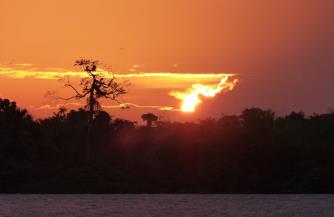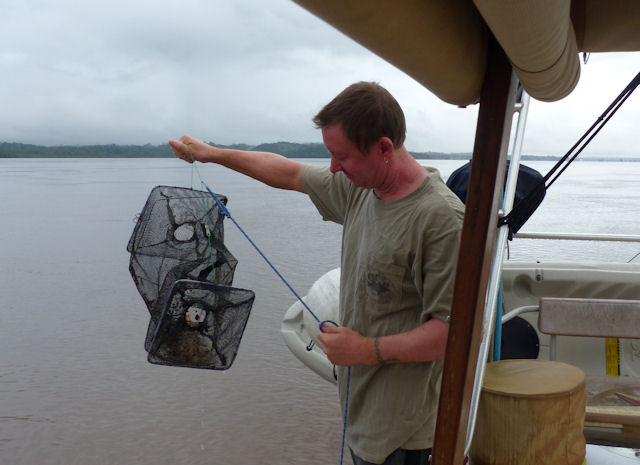We pulled into Saint Helena at 3am, another nighttime arrival, but with a beautiful big moon and a good idea of what to expect (thanks to friends aboard S/V Egret) it was a breeze.
17 April 2015… Saint Helena: at the Corner of "No" and "Where"
When sending off email underway, I often like to put in the subject line “Greetings from the Middle of Nowhere”. I have done this when we are a floating speck in the great big Pacific or the interminable Indian Ocean but this time it’s a little different because we are actually on a speck of dirt in the middle of nowhere! Situated in the centre of the South Atlantic, Saint Helena and her sister islands of Ascension and Tristan de Cunha have to be some of the most remote places on planet earth. It’s largely unreachable: Saint Helena’s first airport is to be completed in 2016 but until then it continues to be serviced only by the Royal Mail Ship that arrives every 2 weeks bringing passengers and supplies. She is the lifeline to this little rock which is in stark contrast to its history when passing ships depended on the island for fresh water and food, not the other way around. These days, the locals also depend on the tourism from the RMS as well as from the few cruise ships that stop in here. (We missed The World by only a couple of days –that would have been interesting to see!)
Still, we’ve really enjoyed our time here in Walvis Bay. It’s given us a chance to chill out, catch up on some web stuff, catch up with old friends and make some new ones. We were very warmly received by the locals here at the yacht club -Travis even met his Namibian counterpart so there was a lot to talk about! And last night as we left for the final time we received equally warm handshakes and hugs and come-back-agains which was really nice; good vibes all around.
Today Fang will be finished working for a while as we leave this fantastic continent and begin our longer passages across the Atlantic: 14 days to St. Helena, 7 days to Ascension, 12 to Brazil then another 12 to French Guyana and Suriname though it may take longer because we’re expecting lighter winds. Then it’s the Caribbean. Soon we’ll be right back in our own backyard!
8 April 2015… Big Crossings
The run from Namibia to Saint Helena took 12 days and was, on the larger scale, uneventful. On the smaller day-to-day scale, it was quite busy because the benign conditions couldn’t decide what they wanted to do! Departing Walvis Bay, we had consistent winds for 2 days before it dropped off, which was what we were expecting, but it didn’t quite fill in again until about day 9. In the interim, it was jib-in-jib-out, engine-on-engine-off, spinnaker-up-spinnaker-down for several days. You might think, “What’s the big deal? It’s not like you have anything else to do out there!” but when these shenanigans must be performed in place of sleep, it starts to wear as does the motion of the ocean when there’s no forward propulsion. The roll was jerky and uncomfortable at times.
It feels like another little milestone to have arrived here in Cape Town and we’ll spend the next few days playing tourist before we have to leave this fantastic country early next week.
8 March 2015… Cape Town & Surrounds
We spent so much time waiting to get out of Simon’s Town that there wasn’t much time left for Cape Town! As I mentioned in an earlier post, we’ve already taken in the walking tours while in the city on other business and we’re now very glad we did as our time here has been rushed. These walking tours familiarized us with the downtown area and its cathedrals, public gardens and government buildings all of which are of historical interest. St. George’s is a symbol for democracy in South Africa as Reverend Desmond Tutu gave anti-apartheid speeches and led demonstrations from its front steps -right across the street from the government buildings! From the steps of city hall, Nelson Mandela delivered his speech promoting peace and reconciliation just hours after his release from prison. In front of the courthouse still sit the apartheid benches: one “whites only” and one “non-white only”. And though perhaps of less political impact, we also got to visit Cape Town’s oldest resident, a pear tree dating back to circa 1652!
Our meanderings took us as well through Bo-Kaap, one of Cape Town’s oldest neighbourhoods. It’s also known as the Malay Quarter as its original inhabitants were slaves of mostly Southeast Asian descent brought over by the Dutch in the 16th and 17th centuries. It’s a colourful little community and I mean that quite literally! Once apartheid was over, the residents painted the buildings in myriad colours in
best effort not to look like yummy seals. Not a difficult task. What was a task was the dive itself as the conditions were very demanding: a long surface swim to the site in medium-choppy seas and a decent surge through the funky kelp forest below the surface, plus the cold water had us pooped for the rest of the day! But it was totally worth it.
Capetown is only an hour away by train so it’s really been no hardship being “stuck” here. We had a friend from our overland trip come down to visit us and the penguins; probably more the penguins but we managed to ply him with rum and ocean fish for dinner so he stayed! Likewise, we’ve met up with boating friends in the city and we’ve also taken in some touristy stuff. We made the trip in yesterday for a couple of historical walking tours of the downtown area and the Malay Quarter and it was a great day out.
It’s been far from all-play, though, as we’ve been wrapping up our chores. Laundry, fuel runs, provisioning, cooking and filling the freezer with passage food are all expected as we have a lot of long passages coming up. Not expected was a nasty toilet repair and a hitch at the dentist’s office that may delay our departure. We’ll know more about that tomorrow. In the meantime, I’m furiously working on getting our courtesy flags finished and the website updated as we’re anticipating a Tuesday arrival in Cape Town and a departure from there shortly thereafter. However, as we know, Mother Nature (and maybe the dentist!) is the boss so we’ll just hold thumbs and hope for the best.
3 March 2015… The Cape of No Storms!
We had to wait a long time for it but it was a delightful passage from Simon’s Town to Cape Town. Notice I said “passage” and not “sail” as we had to motor the whole way but who cares!?! As our first passage in months, it was vital that it be a good one, especially around the potentially dangerous “Cape of Storms” which has recently had winds of up to 70 knots!
After a midnight departure we made our way down False Bay where we had a big fat moon over the Cape of Good Hope and a ring of fog around the bottom of the mountains. Beautiful! Unfortunately, it was also a good view of the local fires that are ravaging this area right now. Six homes have been lost so far and they’re nowhere near stopping it. So sad. It’s safer on the water right now.
1 March 2015… Home is Where Calico Jack Is, Part II
Last night while I was making dinner I heard a passerby say, “Calico Jack is still here.” That’s what we think every day when we check the weather! We’ve been back here in Simon’s Town for two weeks now and while we’re enjoying it, it’s time to get around the corner to Capetown and points further afield. But as I mentioned in a previous post, it is Winnn-Deeeee here! They didn’t originally call it the Cape of Storms for nothing and we need a good window to get around it. We did have one opportunity just days after we got back but we passed it up because we weren’t ready and now (hindsight being what it is) we’re kicking ourselves. We only need 12 hours to get there –in fact, only 6 hours to get around the cape itself- but every time it looks like we’ve got it, the window shrivels to a sliver. So here we sit, grinding up against the dock (or blowing off of it) in what we would consider to be tropical storms conditions; here in Simon’s Town, it’s just another breezy day for this time of year! And it blows sand everywhere without apology: in your shoes, in your hair, sticking to your sunscreen, down your shirt... We came back from the grocery store the other day and I felt like I’d spent a day at the beach! I had a tight grip on our bags, too, thinking it might be all I’d have to eat when I arrived in Oz –and I’m not talking about Australia. Hang on, Dorothy!!



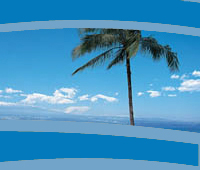
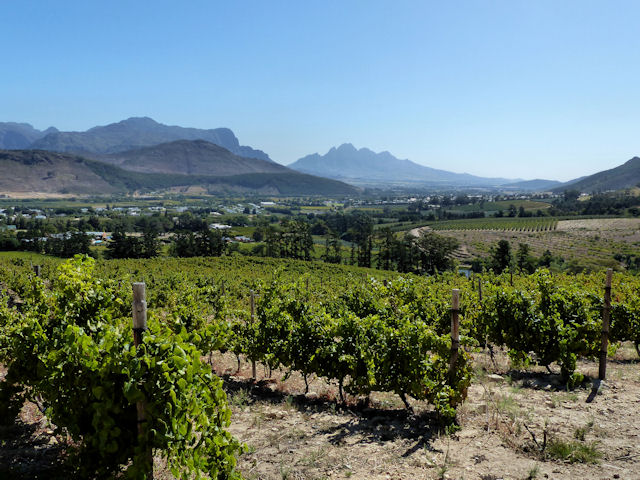
2012: A Sea Odyssey


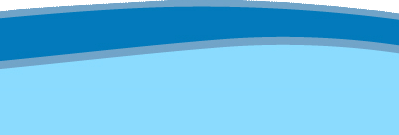

S/V Calico Jack
2012: A Sea Odyssey

Cape to Caribbean
Nonetheless, we’re huge fans of Simon’s Town. We came home to find our girl very well taken care of as she had plenty of eyes on her while we were away: friends who were here when we left, friends who arrived and departed while we were away(!), the marina staff and of course our local friends Jeremy & Anita aboard S/V Jerrican without whose help we may not have secured a spot in such a great place to begin with. While Calico Jack has historically taken care of herself, the wind and surge conditions here in South Africa are challenging and she needed some extra help with lines and fenders. We very much appreciate the help of everyone who had a hand in keeping her safe and secure while we were gone. It was nice not having to worry, which is what we would have done had we had to leave her somewhere else.
(Arriving home to Simon's Town by train.)
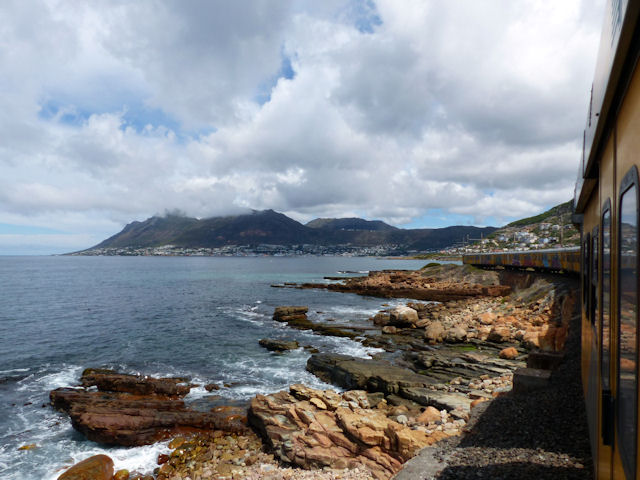
Simon’s Town is more than a safe haven for precious boats, it’s also a charming little tourist town. We had to race away all too quickly in December but now we’ve been enjoying its chill atmosphere and everything else it has to offer. First off, it’s home to a large colony of African penguins. And let’s be honest: you can’t possibly get tired of penguins (we’ve been to see them twice already!). They have a national park where you can observe them in droves but we’ve more enjoyed the up-close encounters on the adjacent public beach. While there are warnings that they bite, they certainly are used to humans as they seem hardly fazed by us cautiously approaching them for a photograph. And we just don’t tire of watching them wobble and hop around on the rocks and do belly flops in the water. They are so adorable that we’ll probably be back once more before we leave!
(A cute couple. African penguins mate for life.)
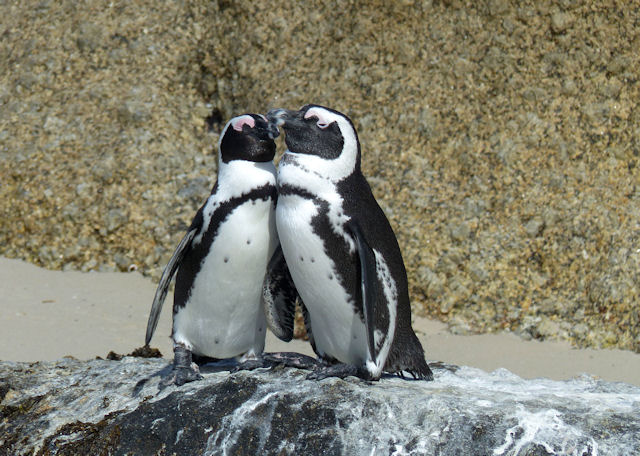
Another specialty of this area is cage diving with great white sharks. We seriously looked at this because it’s the only place in the world to do it but it seems like a racket: they jam 4 people in a cage like a pack of sardines with hooka rigs (with the air supply on the boat) and dunk us just below the surface for viewing. We thought we would be down 30ft diving with real tanks but nobody offers this. To boot, this second-rate experience is worth $160. We decided instead to go diving with cow sharks -sans cage and with a smaller group hosted by a local family-run company- and it proved to be much more our speed. The locals call these rare guys “dinosaurs” because they’re the most primitive of all shark species, having hardly evolved at all from what we know of their ancestors. They have the unique distinction of bearing 6 or 7 gills instead of the 5 other sharks have and yes, you get close enough to see them. They’re very curious and they get WAY close. Close enough to touch –I had to back away from one! And while I’ll mention here that they’re not vegetarians there’s no need to worry, Mom, as they’re used to us two-legged mammals, PLUS we made our
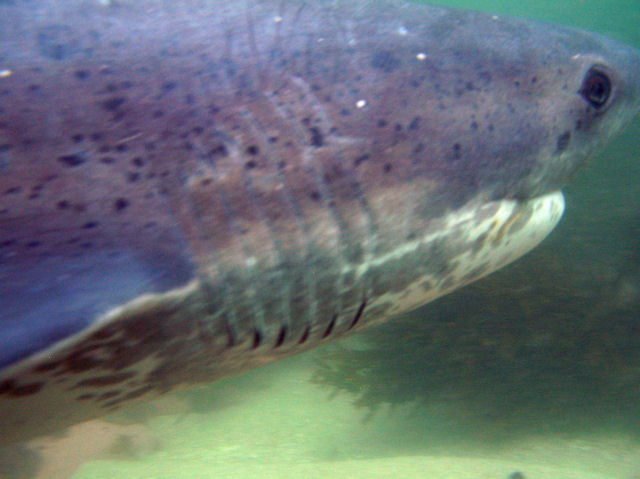
 | ||||||

World Tour Archives:
As we rounded the tip of The Cape of Good Hope during my late-night watch, we turned so that the wind had more access to the cockpit and it was so cold it about cut me in half! But it’s all North from hereon in = Equator, here we come!! After a sunrise over The Cape from the other side, we enjoyed the company of dolphins, seals and the occasional penguin as we made our way over flat-calm water. As we made our approach to the waterfront the ambient air turned suddenly to warm and then again to hot in the space of about 15 minutes! It’s the first time in ages we’ve actually felt too hot -41 Celcius and it feels great! As we pulled in to the Royal Cape Yacht Club we were glad for the calm conditions because the fairway and slips here are quite skinny. Hopefully we’ll have the same luck when it’s time to leave.
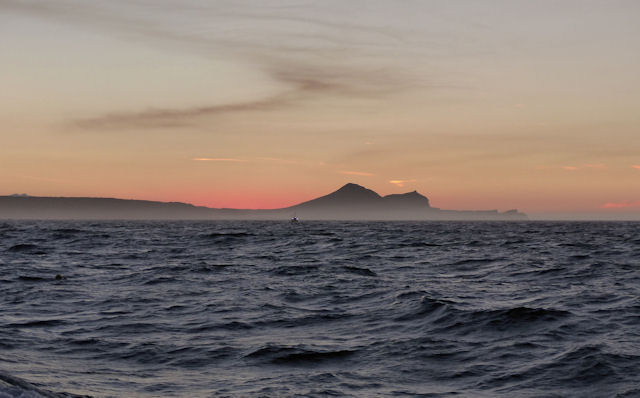
(Sunrise over the Cape of Good Hope)
Back on the bus for our last round, we passed the wine route and the township because we didn’t have time to do those tours but we did stop at the pleasant seaside community of Hout Bay briefly to play with the seals. As with the penguins, we never get tired of them!
It had been a very rushed day but we followed it up with a chill evening at a local jazz club which happens to be located in the basement of St. George’s Cathedral. It’s aptly named The Crypt –and why not? It has a fantastic menu and we enjoyed some tapas and wine and local musicians in a unique atmosphere.
Thanks to City Sightseeing Bus’ 363 days/year, we have an extra day to get stuff done before we leave but we’re pretty much ready to go. Our courtesy flags for the next 2 countries are stitched up, the freezer is full of passage food, Yoda (the Kubota) has had his oil changed and we’re all fuelled and watered up. We’ve also been cleared by our dentist to set out on the big Atlantic! And so we cut the lines tomorrow to leave Cape Town but it’s with a bit of sadness as we feel like there’s unfinished business here. However, the ideal conditions for the big water await us and it’s time to get moving.
Photos: Coming soon.
26 March 2015… Our Last Days in Africa
We left Cape Town in flat-calm conditions and waved goodbye to Table Mountain as we motored away. Considering its size and the clear conditions, we were able to bid farewell for quite some time! Passing Robben Island, we were surprised by how developed it seemed to be. There’s certainly a lot more than just a prison yet all those well-maintained buildings have to be vacant since nobody lives there anymore. If we’d had time to take the tour I guess we would be a little more in the know. Instead, we took Calico Jack as close as safely possible and peered at it through the binoculars. I suppose it was cheaper, anyway!
We’d decided to make our first day back out a short one as a fellow cruiser had told us about Dassen Island and it would take only the day to get there. It’s a national reserve so we weren’t allowed to go ashore but it was a pleasant anchorage and, as promised, we had the company of a whale in the harbour. She didn’t get close enough for us to get a really good look at her but it was fun watching her tootle around, blowhole a-spouting. We had talked our friends on S/V Taurus into stopping here with us and we enjoyed a nice dinner and a catch-up as we hadn’t seen them since Mauritius.
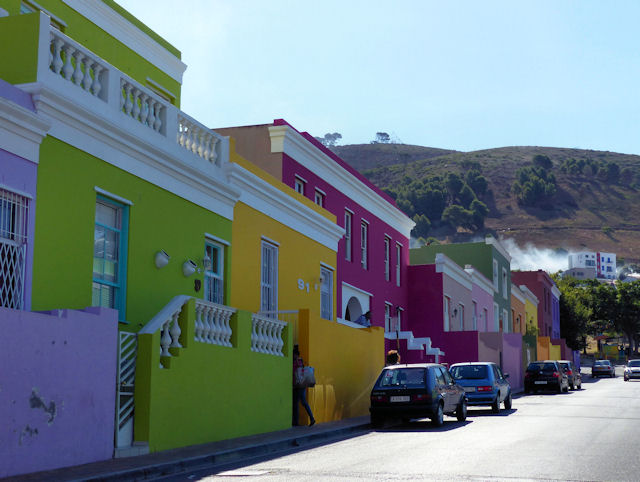
celebration: oranges, pinks, yellows, greens and purples all in the brightest shades imaginable. Though still predominantly Muslim, it is today a multicultural tapestry and its sense of pride shows as you wander down the cobblestone streets past tidy, well-maintained homes and businesses. The original influx of workers included many skilled tradespeople and these businesses have been passed down from generation to generation. The cuisine is fantastic and Cape Malay food has a firm footing here to the point where one of their own is largely considered the South African national dish -but apparently that’s up for argument! Bobotie is a fruity curried meatloaf cooked in egg and served with yellow rice and we enjoyed some at a local restaurant. Afterwards, we wandered down to Atlas Trading, dealers in spices, herbs, teas, etc. where we were given the recipe and ingredients to make our own bobotie at home. Yum! Just being in that store was an experience as we browsed the aisles, peering into large bins of spices where you buy by the big scoop rather than the puny little packets we’re used to! A walk through the museum rounded out a pleasant afternoon in Bo-Kaap.
Cape Town has a host of museums and galleries to choose from and with our limited time, choose we had to: it was hands-down the District Six Museum. Established in the late 1800s, District Six was a vibrant multiracial community until it was declared a whites-only area in 1966 during the apartheid era. Over the following 16 years, 60 000 residents were forcibly relocated to townships, dividing families and ripping the community apart. Their homes were then levelled by bulldozers. Today, District Six stands largely barren, a gaping hole in the middle of Cape Town. The government has committed to building homes and returning them to former residents but it’s taking so long that these residents are literally dying before seeing their dreams realized. We were told that to date only 30-some homes have been built and the people are getting frustrated. What made our visit to the museum so interesting was the opportunity to meet with a former resident of District Six. Noor was born there and he was also there the day its fate was sealed. He told stories of mixed-race families who were no longer allowed to live together and were sent to separate townships with meagre visitation rights. A father might only see his kids every three months and he had to obtain a special pass to do so. The stories were heartbreaking and our visit to the museum was a real eye-opener.
On a happier note, South African wines are becoming very popular in the global market and a visit to Stellenbosch was a must. We booked in at a very pleasant backpackers and did their wine tour which put us with a bunch of kids but it was set up to be a good time. We did tastings at 4 wineries between Stellenbosch, Franschhoek and Paarl and they all had their special touch. Simonsig gave us a tour of their facility (complete with a real cork tree!) and arguably had the best samples on offer. Fairview featured an additional cheese tasting of a half dozen varieties with a wheel of “vintner’s brie” to die for (yes, there is one in the fridge as I write this)! It also had a unique tower where 2 goats live and they climb up and down the stairway on the outside (weird, but cool; this is home, by the way, to the Goats Do Roam brand of wines that are popular in the US). Dieu Donne has the most beautiful vistas over the valley and Boschendal the most lovely old estate home that now serves as their restaurant. It was a good sampling of what the Cape Winelands have to offer.
Stellenbosh is the second-oldest town in South Africa (after Cape Town) and we spent the following morning on a self-guided walking tour that shows off farmhouses, cottages, churches, hotels and educational institutions that date as far back as the early 1800s. Of note is Oom Samie Se Winkel (Uncle Sam’s Shop) circa 1904 which remains a rural general store and we enjoyed browsing its packed little rooms of souvenirs, spices, kitchenware, antiques, novelties, dried fish (p.u.!) and more. It took us most of the day to do the whole walk around town but we managed to break it up with a fine lunch and another wine tasting. It’s hard work!
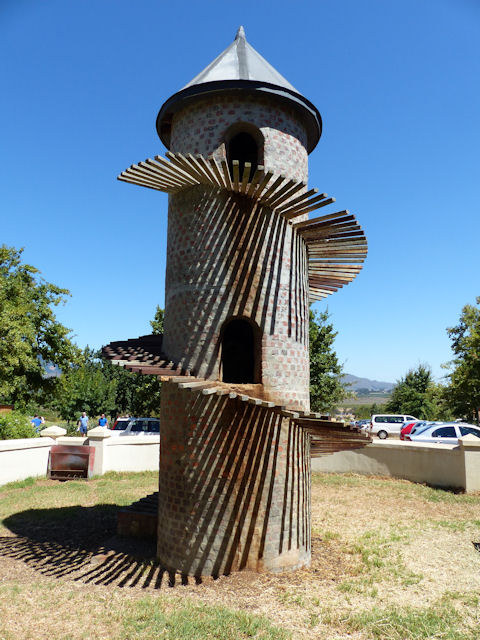
(Goats Do Roam in this tower at Fairview!)
Back in Cape Town, we had only two more days to spend and they had been meticulously calculated for weather conditions on the mountain and opening hours of the attractions we wanted to see. Imagine our disappointment and frustration to arrive at the City Sightseeing Bus office to sign up for their two-day trip only to discover they’d be closed the following day. What?!? I had double-checked
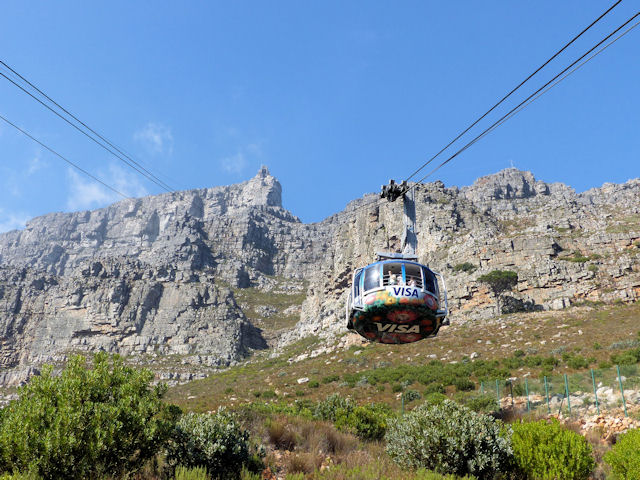
the website and it said “365 days/year” but apparently it’s only 363 as they shut down for 2 days due to a peninsular bike race. Just our luck! So we had to cram two days’ activities into one and there was no time to spare. We were forced to do Table Mountain right away and it wasn’t the optimum time. On our various trips into the city the mountain had always been clearly visible but as we approached it that particular morning we watched as the clouds began to spill over the top, cloaking in its “tablecloth” as the locals call it. Luckily, as boaters we’re not sticklers for the best time to see things ever so we actually considered ourselves quite fortunate that the corner of the mountaintop we were standing on was clear while we got to watch the clouds roll in around us. We’re all about character! Table Mountain is one of the New 7 Wonders of Nature and you can hike it or tram it like we did. At the top it seemed to have its own little ecosystem, too, as rock hyraxes (furry gopher-type guys) nestled in the crevices and flowers popped out from the odd crack in the rocks. There are a lot of hiking trails to discover but with our limited time, we just enjoyed the views of the city and harbours below.
Back on the bus, we were routed through the beautiful eastern shoreline communities of Camp’s Bay, Clifton and Green Point past beaches and parks, cute streetside eateries, posh condominiums and the new stadium that hosted the FIFA World Cup in 2010, a source of national pride. All the while, we watched the mountain and she looked clear (sigh!).
The Kirstenbosch National Botanical Garden is located on the eastern slope of Table Mountain and is recognized as one of the premier botanical gardens in the world. It was easy to watch a few hours disappear here as the grounds are huge and have a lot of interesting features like the Water-Wise Garden demonstrating how to plant a patch and maintain it with limited water; a garden of useful plants like those for medicines, food and household purposes; the Endangered Garden; the Fragrance Garden where you can touch and smell everything. And so much more! We enjoyed a treetop walk on a bridge 11.5m up through centenarian trees, a stroll through the Fynbos Garden (their local bush) and the oldest part of the park, nestled in the thickest part of the forest, featured a spring pool shaped like a bird. Egyptian geese and guinea fowl were among the locals sharing the immaculately maintained spaces and it was nice to see people out enjoying picnics with their families on the weekend. They even have a bandstand set up for concerts during the summer. While we aren’t here at the best time of year to see the local stuff blooming (I really wanted to see a protea, the national flower, but no joy), with 7000 species of plants represented one could hardly complain!
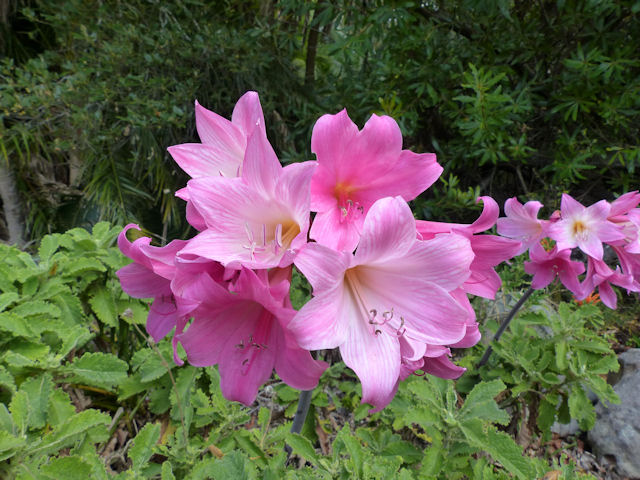
Arriving here at night proved to be a bit of a challenge. It’s a major port so it has a well-marked channel and at the end of it is supposed to be the yacht club. So we’re happily chugging along at 2am, anxious to drop anchor and get a good night’s sleep (what was left of it, anyway) and instead of the anchorage we encountered… a road. Right across the channel between us and the yacht club. Unbeknownst to us, there’s a huge dredging project going on here right now and it isn’t shown anywhere on our charts. We could see where we needed to be, but how to get there? We puzzled around the area for a bit until it got very shallow, very quickly and we decided it wiser to pull over and wait until morning. Once we could actually see, we discovered that what had looked like a shoal the night before was really just muddy-coloured foam from the project and a boat was out trying to disperse it with water pumps. Apparently, that was the first and last day it was there, it just happened to be our day.
It was a 6-day passage to cross the border into Namibia and arrive here at Walvis Bay and it was an easy one. We got to enjoy the company of dolphins and a lot of seals that would follow alongside the boat. On one occasion, Travis called me up top to see a patch of water that was boiling furiously. Usually this is a pod of dolphins jumping but this time it was seals! A lot of them! There’s certainly a good amount of life in the waters this side of Africa and even here in the anchorage we’ve seen pilot whales, dolphins and many, many seals. The seals bark just outside the boat, making each of us think that the other is saying something (“What did you say, honey?” “Nothing, it’s just a seal!”). They follow boats and dinghies around and yesterday we saw one up on the bow of a charter boat just enjoying the ride! We’ve been leaving our dinghy out as bait (just as we did our kayak in the Galapagos) but no one has cared to join us just yet.
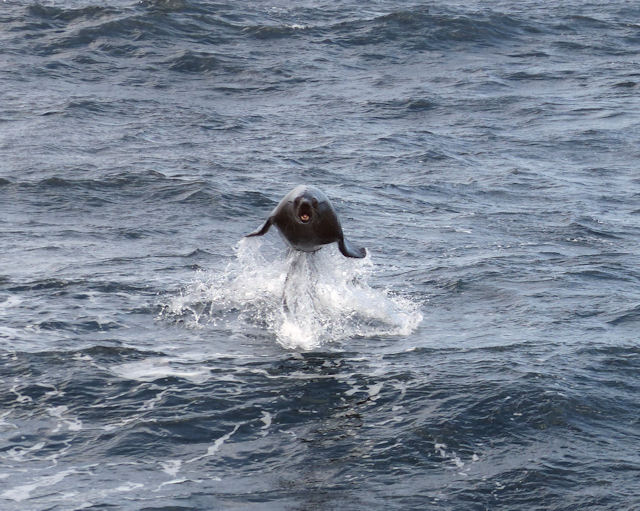
Our leisurely afternoon came to an abrupt end, however, as we received a text message from friends telling us that Calico Jack was dragging anchor! Usually this would be a panic situation, especially since we have land behind us, but we knew that friends were onboard paying out more line which generally solves the problem. Of greater concern was the fact that we might have hit someone else’s boat but apparently she slid gracefully past everyone without inflicting any damage whatsoever and by the time we reached her she was all settled in her new spot. It wasn’t a lot of drama –for us, anyway! It sure is nice, though, to find out that friends were concerned enough to panic on our behalf! What was the most troubling for us was that trusty Fang had failed after we had backed down in two directions to ensure that he was properly set. All was answered the next day when we pulled him up to reposition ourselves only to discover that he had skewered a large piece of corrugated sheet-metal. A serious handicap and you have to give him credit because he had reset so hard that we needed to break him out with the engine! We still love our Fang.
Once safely situated in the actual anchorage, we were pleased to see a couple of familiar boats and it’s been nice catching up with friends. Patrick & Amanda (S/V Egret) were just arriving back from an inland trip, they had the car for one more day and invited us along on their afternoon excursion. We drove out to Dune 7, climbed 130m to the top of it and had a blast running down its side. “Scree jumping” they call it, except we're doing it in the sand and you sink into it as you take giant strides. It looks like you’re running in slow motion but run you must because the sand starts to get very hot by midday! Then we took a drive through the otherworldly salt pans which looked more like a scene from snowy Saskatchewan than the desert. Walvis Bay exports over 700,000 metric tons of salt annually and they were moving big piles of it around with front-end loaders and augers. The pans seemed to go on forever as we drove through the varied landscape from sand to mud flats to lakes to “snowscape” to pink lakes and snowscape! There’s a red bacteria that lives in the blue-green algae here that plays an important role as the darker colour increases heat absorption from the sun which in turn increases the temperature of the water and so also the evaporation rate. Interesting!
Next up was the Walvis Bay Lagoon which is one of the most important wetland areas in the southern part of the continent as it’s home to key plankton, fish, marine mammals (as we’ve seen!) and also a vast number of migrating bird species. Around 50 species, to be more precise, and in the winter season there can be over 200,000 birds hanging out here including gulls, terns, plovers, cormorants, pelicans and two kinds of flamingos. These are pink flamingos as they feed on that blue-green algae with the red bacteria in it (even the pelicans have a pinkish hue!). They congregate in large numbers and can commonly be seen right beside the road poking through the mud flats at low tide in search of snacks. If you’re perfectly still they come very, very close and it’s quite a sight to see them moving about en-masse like a pink cloud!
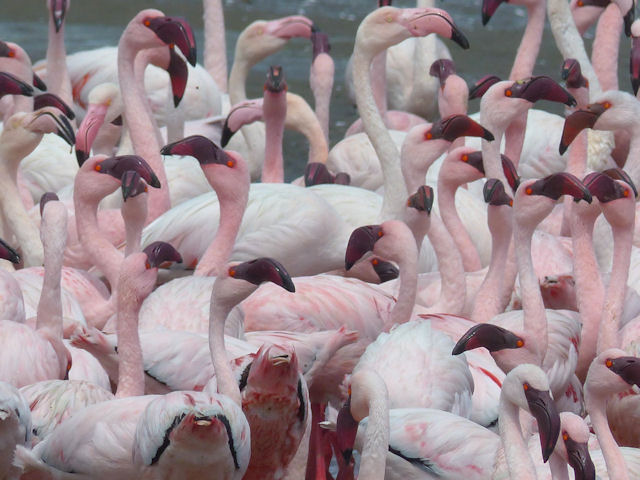
So you might have guessed that the conditions here can be pretty extreme. Almost like clockwork every afternoon the wind kicks up and it can get pretty hairy. We rush out in the mornings to get all our errands done and have spent many an evening at home on anchor watch when we’d rather be in at happy hour. The wind brings with it the sand which coats every surface of the boat and it’s also very humid so it sticks to everything. We were hoping to get our woodwork done here but no dice as there are only a couple of hours in the morning where it’s even feasible to hang your laundry out to dry (of course you have to wipe all the sand off your life lines first!). And COLD! Oh. My. God. How can it be this friggin’ cold in the desert?!? It was so cold on passage that even with additional additional clothes we were doing our watches from down below, sticking our heads up every 10-15 minutes. And here in the anchorage, needless to say, this amounts to a whole lot of cold, wet dinghy rides to shore.
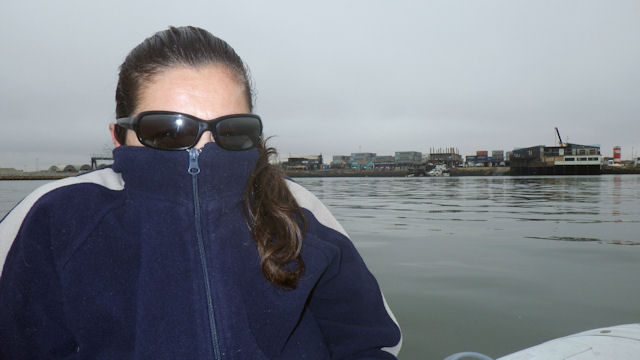
(Another frigid dinghy ride but at least it's calm today!)
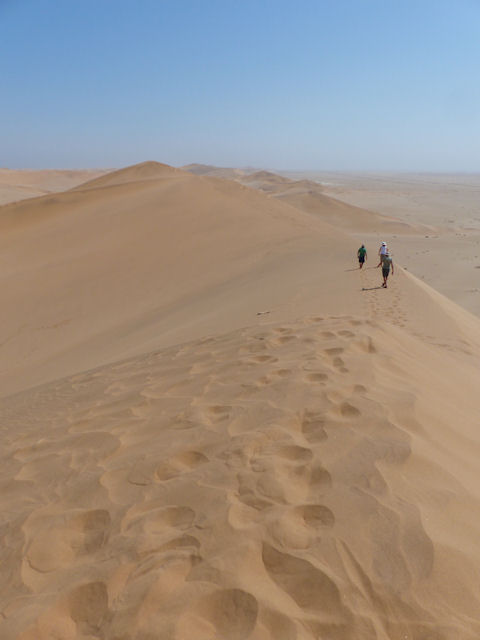
(Whee!! What a ride!)
But as we’ve already been told (through jealous teeth), nobody really cares about our problems out here! So the Miss-Mary-Sunshine Report will add that each passing day found us blissfully warmer. Every morning had us shedding one layer of something-or-other that didn’t need to be put back on for night watch and Day 4 was so sunny and beautiful that we celebrated with date night on the stern rail to watch the sunset. By Day 5 we had put away the mittens and sweatpants and were braving it in shorts (gasp!). Once the sea conditions had sorted themselves out it was actually nice enough to be down below cooking (me!) and we got a couple of good days of spinnaker sailing before proper wind settled in for good. The ocean is back to a beautiful shade of blue and the bioluminescence was particularly fireworky, the likes of which we haven’t seen since our passage to Cayman way back in 2006. Of note on this trip is that we have crossed both back into the tropics at 20 degrees as well as back into the western world across the East-West Greenwich Meridian. Both kinda big deals.
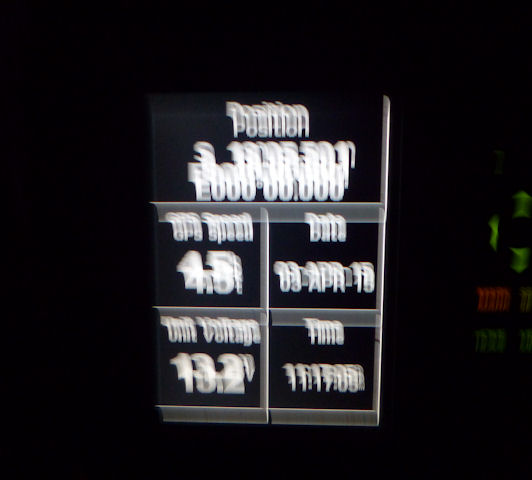
(All those zeros after the E means we're on the east-west meridian. From now on that E will be a W!)
Saint Helena is a place one could easily get stuck in. The island has a wonderful atmosphere, the people are friendly and what’s not to love about a place that boasts a heart-shaped waterfall? Awwww. And there was so much left to do and see: churches, forts & other historic buildings (their government offices are in a castle!), coffee plantations and walks. So many wonderful trails to discover. But the weather was looking good to leave so… you know the story. The harbour master gave us a call on the radio as we departed to bid us a special farewell (we had chatted with him quite a bit during our stay) so we left with the warm-fuzzies, too. Farewell Saint Helena, we hope to make it back again another time -don’t go changin’ too much!
So it’s a pretty special place and we’re not the only ones who think so: it’s on the shortlist for UNESCO World Heritage Status. Nicknamed “The Galapagos of the South Atlantic” it’s home to over 500 endemic species -a staggering amount for a rock only 10x6 miles in size! Lush green peaks at its centre and arid rocky formations around the perimeter provide a host of habitats for plants and animals alike. Of note is a unique cabbage tree species whose males and females are readily distinguishable. They call them He- and She-cabbage trees –how adorable! And there’s also the Saint Helena Plover or “Wirebird”, the only remaining of 9 endemic bird species. A bit of a local celebrity, its figure graces the coat of arms and the flag.
Saint Helena has a famous side to its history, too. In 1673 Edmond Halley (of Halley’s Comet fame) set up an observatory here to study the stars from the southern hemisphere. The remote island has been home to many prisoners the most notable of which was Napoleon Bonaparte who was exiled here in 1815. And in 1898 American Joshua Slocum stopped here on his solo round-the-world voyage. This was of particular interest to us since Slocum hails from New Bedford, Massachusetts. Travis could see where he built his boat, Spray, right from his bedroom window!
The capital of Jamestown is charming and very English (so say our English friends) and access is gained only by two skinny, winding, hair-raising roads that go up the hillsides. Or, if you’re ambitious, you can get to higher ground via Jacob’s Ladder. Originally it was a donkey-driven tramway but in 1871 a stairway of 699 steps was put in its place. It’s a steep gradient and a good deal of huffing & puffing is required to reach the top of Ladder Hill but don’t mistake it for a locals’ passage as it’s mostly tourists who take on The Ladder, spilling off the cruise ships and tackling those steps on wobbly legs. And every second year people from everywhere converge here to race it. The quickest time so far is 5 minutes, 11 seconds -collect your certificate at the museum gift shop.
We did a lot in our first few days in Saint Helena because opportunities to join others couldn’t be passed up. Public transportation is scant so when you’re offered a ride somewhere, you take it! Patrick & Amanda (S/V Egret) had arranged a hike with a local lady the day after our arrival and we were pleased to join. We enjoyed the varied landscape with many stunning vistas and Valerie was an invaluable source of information about the local flora, fauna and history. The following day a bunch of us cruisers were packed into the back of Robert’s truck and he took us for his own tour of the island. Robert was the school bus driver for 30 years and now he runs a taxi service/tour company so needless to say, his knowledge of the island is flawless and he has a great sense of humour to boot! Of course the Napoleonic sites were a must –a lot of the tourism here is generated by interest in him- and we had a full tour of his house and stood in the very room where he drew his last breath. Then we visited his tomb though he’s long gone back to France. Get this: he had three nesting caskets, each soldered shut to satisfy the French that his body wouldn’t be messed with, and it was so airtight that when it was opened 19 years later the only decay was a bit of mould on his cheek!
Robert took us past the airport-under-construction which is a pretty big deal here and a bit controversial as the increase in tourism will bring with it resorts and such that are set to change the face of this charming island. You can’t stop progress, I guess.
“The world’s most remote distillery” is located in the garage of Paul & Lisa Hickling but don’t think that’s a disparaging comment as it’s a topnotch setup. Paul is Welsh and trained in Germany before marrying a Saint and moving here. A qualified distiller, he has a small but first-rate operation. Their trademark product is a potent spirit derived from the local prickly pears called Tungi (both the plant, and the spirit) and they also produce gin, rum, coffee liqueur and a lemon liqueur I’m sad we left without. Travis and I departed thinking that we SO need a distillery in our garage! Of course, that would first require having a garage…
A big highlight for me was to be a visit with the island’s oldest Saint. His name is Jonathan and he’s a Seychelles Giant Tortoise estimated to be about 182 years of age. This makes him the world’s oldest known reptile and if you think about it, probably the world’s oldest living being! He was brought to the island in 1882 as a gift and lives on the front lawn of the residence of the governor with his friends David, Emma, Myrtle and Fredricka (Speedy passed away last year). Unfortunately for all involved, the governor’s wife had a snit recently about tourists being too close to the house and so she erected a fence making the front lawn a veritable field so your chances of seeing Jonathan up close are a roll of the dice. And when I say it’s an unfortunate circumstance for all, I mean for the tortoises too as we have learned in past encounters that they actually love the attention. They crave getting their necks rubbed and can even feel the contact through their thick shells. Meanwhile the sign on the fence implies that it’s all for their own good. Whatever. I muttered a few choice words in Ms. Whats-her-face’s direction as I made good use of the uber-zoom on my camera. I got photos but it would have been an honour to hang out with the world’s oldest living creature for a while. Over the years he’s seen more than 30 governors pass through here –I’d bet he has some stories to tell!
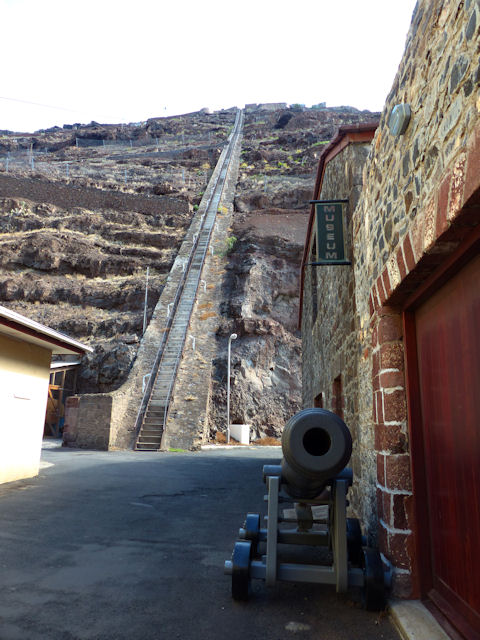
After 3 days of running around it was time to chill out. The water was beautiful so just try keeping Travis dry for any length of time! “I’m gonna go scrape the bottom.” Yeah, right. But while he was down there one day, he had a sizeable manta ray scare the crap out of him! It caught him by surprise but he soon called up for the camera and we spent the next hour trying to get a photo as it was feeding in a circular pattern around the boat. Apparently there had been a whale shark in the harbour just a few days earlier –what a sight that would have been! We’ve essentially been chasing them around the world since 2007… soon come. In the meantime, Travis amused himself by free-diving the wreck of the Papanui right in the harbour. It’s been down there for over 100 years but he still spotted old bottles, dishes and other paraphernalia. I stuck to the surface photographing the butterfly fish that were so plentiful they looked like a snowstorm!
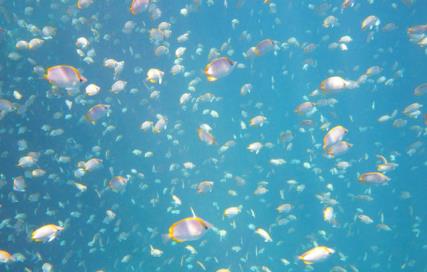
We were surprised by the number of cruising boats that continued to arrive as we thought we were pretty late in the season. Someplace ashore to hang out would have been good in this instance -there were about 20 of us!- but activities ashore are restricted to daytime hours because the ferry service ends at 7pm and landing your own dinghy can be an adventure. So a few of us resorted to splashing our dinghies just so we could go boat to boat for visits. We enjoyed a happy hour aboard Renata, theatre night aboard Tegan and Egret came over for farewell drinks aboard CJ as this might be our last time with them. Again! We met them way back in the Fiji and have been saying hello and goodbye and hello again for over a year now!
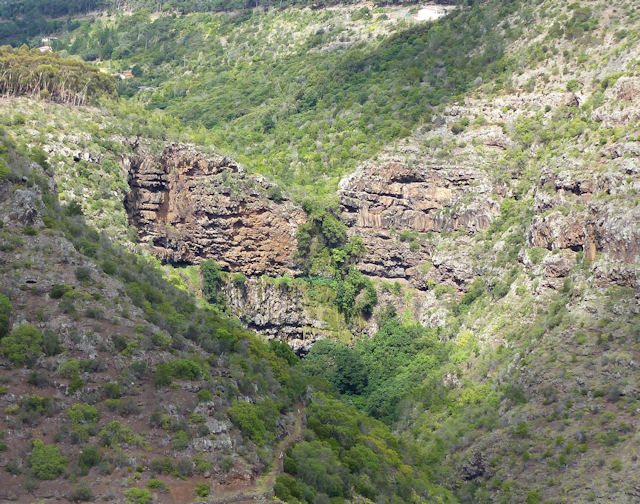
(We heart you, Saint Helena!)
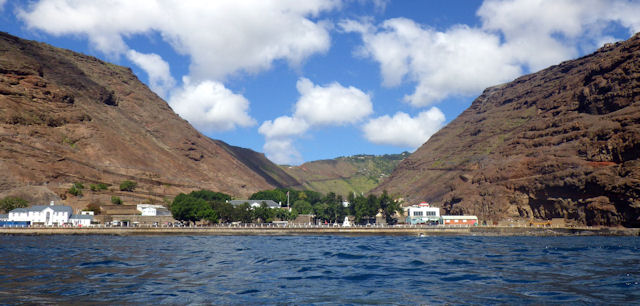
(Jamestown, Saint Helena)
Something that piqued our interest about this place is the existence of a fish they say is a relative to the piranha. We read that they number in the kajillions and that they make short work of the growth on the bottom of your boat! Travis was pretty excited at the prospect of the work being done for him but when we arrived we discovered that this infamous fish is only a type of triggerfish we’ve seen elsewhere. Big deal. Maybe they are related to the piranha somehow but it doesn’t change the false advertising: while they jumped at every little thing that hit the water (even our fenders!) they showed no interest in cleaning the bottom of Calico Jack. We’d spot them every morning and shout at them, “Get to work!” but in the end Travis had to get in with a scraper and do it for them. Bums. Funnily enough, though, they do like to nibble at your toes while you’re swimming –some people pay good money at spas for that!
27 April 2015… Swimming with Piranhas
It was an easy 6-day sail but to an uncertain end as we weren’t sure that a stay in Ascension would be feasible. The anchorage can be quite swelly and landing your dinghy ashore even more of a challenge than it was in Saint Helena, but with no ferry service on offer. As we approached the anchorage just before nightfall S/V Egret (hello again!) was the only other boat there and we had our doubts as we watched her disappear and reappear with the swell and then a second later, huge crashing waves on the shore behind her. But once we had the anchor set we were happily surprised to discover that it wasn’t too bad at all and we slept like grateful rocks.
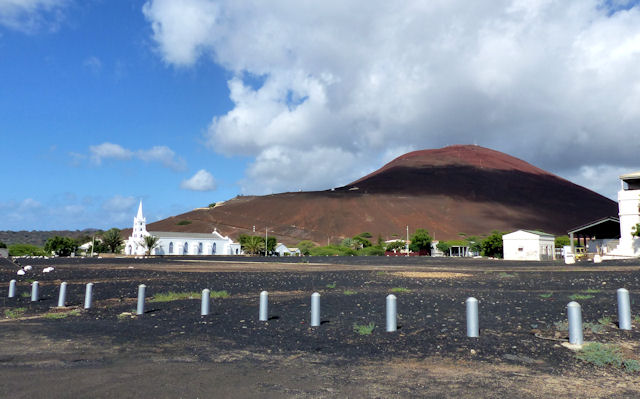
If we thought Saint Helena was Nowhere Land, you can double that for Ascension. While it has the added advantage of being serviced by two weekly civilian flights out of the air force base, the island itself is as desolate as can be. Only 800 people inhabit 4 tiny settlements and an aerial photo we saw of the capital of Georgetown pretty much says it all: a few dozen buildings scattered upon barren red earth. The landscape of the island is interesting: it is arid save Green Mountain at its centre, a cloud forest that is actually man-made -Charles Darwin himself had a hand in planting some of the trees! But apart from this one patch of green, there’s nowhere fertile enough to grow anything as our purchase of a $5.50 cucumber would attest to (not to mention that acquiring it was akin to a battle at a ladies’ shoe sale!). It rivaled our egg purchase of $9.36/dozen in French Polynesia but at least we were fortunate enough to arrive on RMS day or there would have been nothing at all.
Otherwise, our timing in Ascension seemed to be all wrong. Having arrived the same day as the Royal Mail Ship meant a wait to go ashore but wouldn’t you know that THE bank closes early on Thursdays (just because) so we were unable to pay our miscellaneous fees. As such, our passports were held and we were effectively banished to the boat until the next day. We managed to eke out a beer with Patrick & Amanda and an hour’s internet but that was about it -if one can call internet a success here. It’s the same deal as in Saint Helena: slap down $10, type like hell for an hour and hope it goes through! Slow, unreliable AND expensive! That’s Cable & Wireless for you (our Cayman friends are shuddering as I utter this name!). So it goes in the remote places on earth…
There’s no public transportation to speak of and to hire a car is at least a week’s wait. The museum and fort are only open 4 hours per week and we missed those. And the big deal happening on the island at this time of year is the frenzy of nesting green turtles! Tours are conducted but they happen at about 9pm when it’s too late to be dinghying about in these conditions and an early morning run is out of the question because we’re not allowed to be on the island anytime outside 7am-11pm. !!
Out in the anchorage there were a fair number of problems among the only 3 boats that were there. Egret was having a hard time with a pretty serious leak. Meanwhile, they could tell that their anchor chain was fouled in rocks on the bottom and they were worried about damage with the swell. Next door, a catamaran was similarly fouled and when the captain went down to investigate he suffered a diving injury. It was a close call for there’s no decompression chamber on the island (or in Saint Helena) but it ended up being a mild injury –he was very, very lucky. We were over to lend assistance and once Sea Rescue had taken him to the hospital, Travis helped the rest of the crew with the boat issues and went back the next day to dive the anchor which was fouled on a pipe of all things! While he was down there, he thought it best to check on our anchor as well only to discover that we too might have trouble leaving –the bottom is mired with rocks and debris. Talk about some challenging conditions!
I realize this sounds like a bunch of griping but it really wasn’t a big deal. Ascension has only just begun to market itself as a cruisers’ destination and perhaps in time they’ll have proper moorings in place and a more convenient setup for dinghy dockage. As it was, we had no trouble at all but the solution was a bit “alternative” for it meant timing the waves to drop me and all our things off at the dock -dashing up the steps to beat the swell- and then Travis tying the dinghy off to a buoy and swimming in. He’s kind of nuts that way, he likes the challenge. As per our experiences on the island, they were few but we really enjoyed the vibe of this tight-knit community where everybody waves in passing and goes out of their way to help others on an island where amenities are few. We wandered down the beach and spotted some turtle nesting sites, checked out the best book exchange we’ve seen in a while (although it was probably their version of a library!) and just enjoyed some chill evenings in the anchorage both on our own boat and at the neighbor’s.
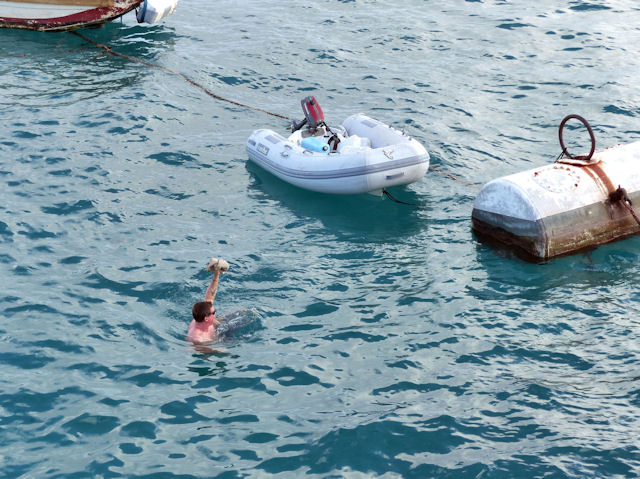
(He forgot to leave his dry shirt and hat with me so he had to swim back with them over his head!)
But the absolute coolest thing we encountered in Ascension was quite by accident. As we sat down to dinner one night we decided to turn on the underwater lights as we sometimes do when the conditions are good and we have lots of power. After a time, it’s fun to see who’s hanging out down below, attracted by the lights. In the past we’ve been treated to sea lions, a jurassic grouper and even a manatee once. We weren’t expecting much here so imagine our surprise to see a small swarm of baby green turtles –OMG!! They weren’t more than an inch and a half long and they were paddling around the transom of the boat. We marvelled for about 30 seconds before we realized –oh crap! We have to turn off these lights! Not only were we making them a perfect target for predators but their natural instinct is to swim towards the light of the moon! Only 1 in 1000 of these little guys reaches maturity and we sure weren’t helping their chances. Thankfully, nobody was gobbled up before our eyes. That would have been pretty traumatic.
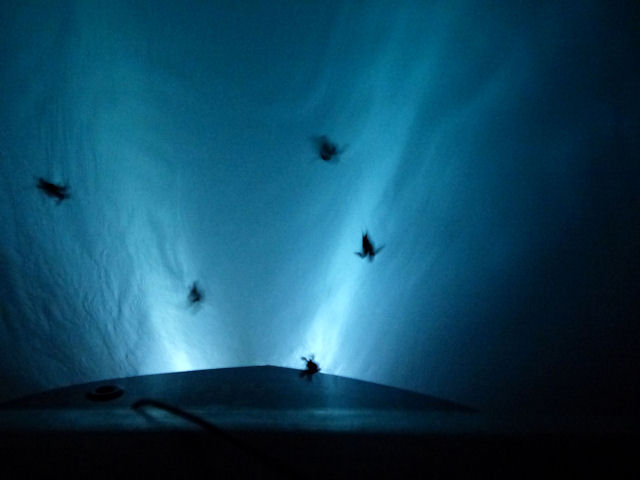
Our stop in Ascension was only meant to be a brief one and it was interesting. We bid farewell to Egret as they left the anchorage (for real this time!) and we weren’t far behind. This was a nice stop before embarking on our next big transit: 1100nmiles to Brazil.
8 May 2015… Brazil: The Bottom Line
1100nmiles in 9 days –woohoo!! It was an early morning arrival at Fernando de Noronha and we were met with a stunning landscape, a true tropical paradise. It’s what I think people imagine when you say “Tahiti”, except Tahiti isn’t (anymore). But Fernando IS! Picturesque bays, pristine beaches and rocky outcrops surrounded by green, green and more green. And so it should be as we got rained on pretty much every day!
Visiting this tropical resort area was in shocking contrast to the more conservative places we’ve been lately, especially as a female. Dressing in more modest shirts with sleeves and longer shorts or even pants has left me with quite a farmer’s tan indeed! Enter: Brazilian beach scene and more bottoms than you would otherwise see in your lifetime. And these tiny swimsuits are not only for the supermodel types as they are worn by younger ladies and older ladies both big and small. And you know what? They rocked them –way to go, girls! Even the mens’ suits that are not quite Speedos (aka: banana hammocks/budgie smugglers!) are very stylish despite the fact that they sometimes mistakenly consider them street clothes… So yes, “The Brazilian” is alive and well down here. And because one exists, thank goodness, so does the other! And that’s the "bottom" line.
Sadly, this is to be our only stop in Brazil. This was not always the plan: way back in Key West we spent an evening on Google Earth getting excited about all the pretty bays and possible navigable rivers there are to explore. We were to wait out the whole Atlantic hurricane season here. Then the reports of security issues began to trickle in, accounts of robberies and assaults on cruisers, so we thought we’d pare our visits down to larger centres with marinas and security. And only an hour after dropping about $400 on visas in Cape Town (in a long and frustrating process) we heard of a cruiser that was shot dead on his own boat just outside a major centre. Let it be said that we do expect some degree of crime in some of these countries we visit; we lock everything up securely and hope that nobody steals stuff out of our dinghy when we’re ashore. We might even expect to get mugged in town but what’s going on here seems to directly target cruisers and that’s unnerving. As it stands at the moment, there is only one other place in coastal Northern Brazil that we know of that is safe. It’s a real shame and not worth the stress even if nothing happens so our stop at Fernando de Noronha has basically amounted to a very expensive insurance policy and it’s money well spent. It was a good break and gives us a decent point of sail as we plod onward. Our next passage will be our last long one: 1300nmiles to French Guiana.
Fernando de Noronha is supposed to be the premiere place for diving in Brazil so some time underwater was a must. We booked in with a local company and prayed the weather would be good the following morning (wind doesn’t matter so much but the lighting is important for good photos). We fared pretty well with that but were very surprised at the lack of coral life for being so close to the equator –pretty much nothing! This is the best diving the country has to offer? But I guess the selling point is the excellent visibility and we could see about 80ft even after a good rain the night before. We saw a reef shark, a few rays and some interesting medium-sized fish the most notable of which was this lovely peacock flounder. It was a nice easy dive after our last challenging one in South Africa and I had a great time flying around down there despite some equipment malfunction (oops, dry rot!).
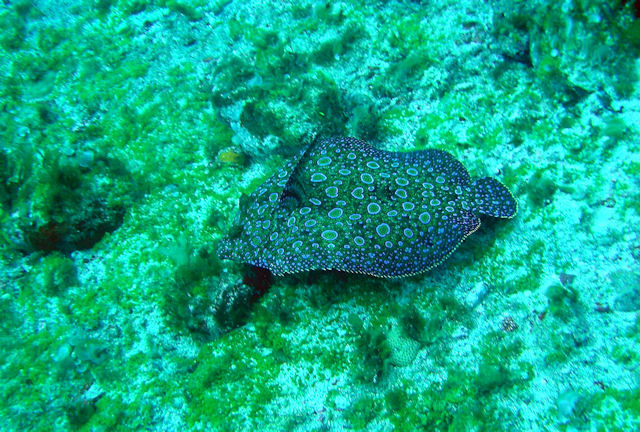
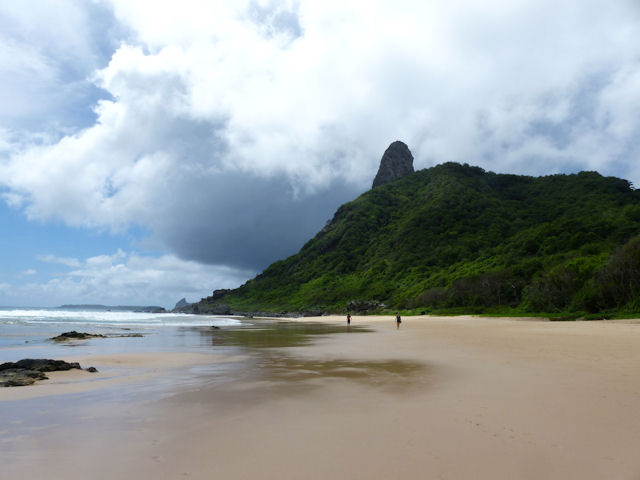
At $120/day for us and the boat, this was an expensive stop so it was to be brief and the time maximized! The first day was spent getting checked in and everything in order but on Day 2 we rented a “buggy” and paid our admission into the national park (goodbye another $180 -oy!). We were originally going to rent a scooter for the day but once we got a taste of the roads we were very glad we’d sprung for our 4WD vehicle. Just our luck that we got a lemon with questionable brakes and an overheating problem but we lumbered and mucked our way through some pretty dodgy trails in the forest –my camera stayed safely tucked away in its waterproof case to protect it from rain AND mud! But what an adventure. We checked out some of the most beautiful bays and beaches we’ve encountered, and you know we’ve seen our share! One beach is accessed via a swim ladder down a 30ft crevasse, just room enough for you and your backpack; a short walk through the skinny dripping crack in the rock then another shorter ladder before you see sunlight again. A small waterfall meets you at the end then a trail through forest takes you to a pristine beach backed by multicoloured cliffs. Add another waterfall! Utterly beautiful and
surprisingly, relatively deserted. One would expect these beaches to be packed but I suppose it’s so expensive that not everyone can afford to come here. Part of its charm, no doubt.
(Looks like a magic carpet.)
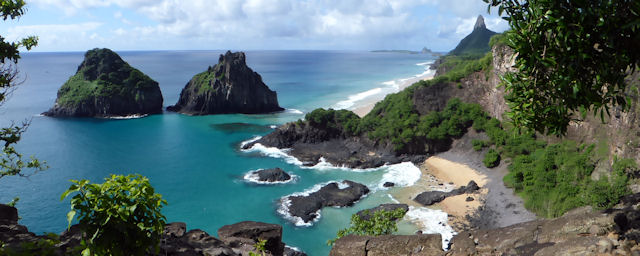
About 15km off Kourou lie the Îles du Salut, the Salvation Islands. These three islands are notorious for their penal colony and Devil’s Island, where the worst of the worst were relegated, was made famous by an escaped convict nicknamed Papillon who wrote a book about it. In 1972 a movie was made about his time here and his escape, starring Steve McQueen and Dustin Hoffman (neither of whom, funnily enough, had the slightest of French accents!). Despite the morbid history, the islands are quite lovely and we enjoyed strolls around Ile Royale and Ile Saint-Joseph, meandering through the old prison buildings, some restored and others rotting away. It’s always interesting to see how quickly Mother Nature reclaims things. Conversely, the navy infantry buildings have been turned into an inn and restaurant (!) but there are still nice wilderness walks to be had and we even encountered two groups of monkeys who were very keen to take pieces of coconut right from our fingers!
28 May 2015… Raindrops, Rockets and Rage: French Guiana, Part 1
Our last long run under our belt, we arrived in the Guianas skidding in sideways: low on fuel, propane & washing water, out of passage food & sat phone minutes. We chuckle as we think back on the over-preparedness we practiced for that first (and longest) run across the Pacific oh-so long ago. We were loaded so heavily leaving Panama that the boat actually wallowed and we probably lost a knot of speed overall with the hulking pile of foodstuffs we had stored to get us through the cost-prohibitive Polynesian Islands. We even had a spare bladder of water weighing down the bow in case we ran out on the crossing! Did we spend just as much money in extra fuel as we saved in groceries, propelling our overloaded barge through the islands? After all, dollar bills don’t weigh much. But we’d have to say that overall it probably balanced out –remember we had no engine for the majority of that longest run (talk about fuel savings!). And anyway, French Polynesia had crap for good rum so we were certainly glad to be well provisioned in that regard! These days we still play it safe but we have a much more laissez-faire attitude as we embark on our longer crossings. Let me be clear that safety for us and the boat is still paramount -we just don’t sweat the small stuff as much anymore. After all, ravioli straight out of the can and a sink full of dirty dishes never killed anyone!
Our first port of call in French Guiana was to be Degrad des Cannes but at the 11th hour we decided to blow off this very commercial and dirty-sounding port and head directly to Kourou. It was a couple of hours up the muddy river (muddy enough to conk out the depth sounder a couple of times, eek!) to the calmest anchorage we’ve experienced since leaving South Africa. No rest for the wicked, though, as uncertain holding on the silty bottom and line after line of squalls made for many sleepless nights. And mosquitoes. Don’t forget the mosquitoes. Still, we got enough rain on the first day to fill up our nearly-empty water tanks so that was a good thing; we thought that if only fuel and propane would fall from the sky, too (in tidy containers, of course), we’d be in pretty good shape! This was our introduction to rainy season on this part of the continent: the sky opened up not an hour after we set the hook and it pretty much hasn’t stopped since.
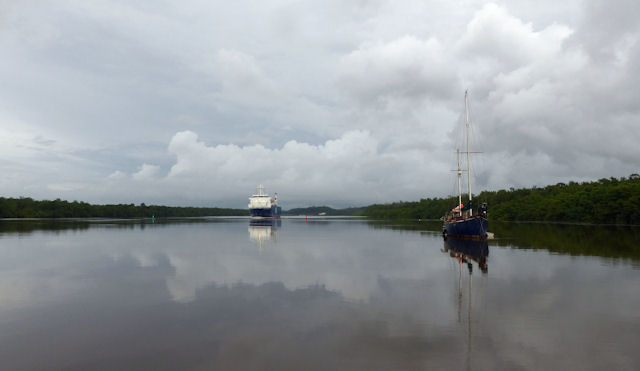
Kourou isn’t a very remarkable town but the people were friendly and check-in was a breeze. This is pretty much standard for any French country. They just don’t seem to give a rat’s about where you’ve come from or where you’re going next, unlike many other countries that require you to check in and out of each and every one of their own ports. Here, we were told that check-in isn’t even really a requirement (*note: if you ever get into trouble somewhere with your boat and need to flee, head to a French country!). However, we needed the paperwork for points beyond so off we went to find the office. This was no small feat, as it turns out. There is no port captain. There isn’t even an immigration office but we were directed to the main shipping port for customs. We arrived at the guard shack and a man in uniform emerged immediately and very nervously he told us that he was going to have to ask us to leave! Nor could he even give us directions as to where we were supposed to be so we wandered off in the general direction we thought we should be going until a kind local picked us up and took us along a goat path through some trees to a building we never, ever would have found on our own. It left us bewildered as to why the guard had been so nervous –like he’d never had a foreign cruiser show up looking to check in when three people had sent us to his very obvious location…
The one point of interest in Kourou is Europe’s spaceport, The Guiana Space Center. This tiny French overseas department might seem an odd location from which to launch rockets but in fact it was chosen for very specific reasons and is considered by many to be the most efficient site in the world for its purpose. 1. Its proximity to the Equator provides an extra boost of energy due to the faster rotation of the Earth. This “slingshot effect” allows for greater efficiency in launching larger satellites, effectively reducing the cost to do so. 2. Located on the shore of the Atlantic Ocean, it has open water for 3500km north and east so it can launch directly into all orbital levels i.e. for high, medium and low orbit applications, and with no threat to local populations. 3. Being away from hurricane and earthquake zones, it enjoys both seismic and climatic stability.
Three “lines” of rockets are launched here: Ariane 5, Soyuz and Vega. It’s a diverse fleet in terms of size and capacity and so this centre boasts the full gamut of services available to its customers. Ariane 5 can launch up to 10,000kg into high orbit and “tiny” Vega has a capacity of up to 1,500kg which it can deliver into low orbit; Soyuz is the man in the middle (and a shared venture with the Russians, by the way). We’re talking mostly satellites -research, navigation and telecommunications- but some of the missions are to deliver supplies to the International Space Station. They don’t, however, launch people from here.
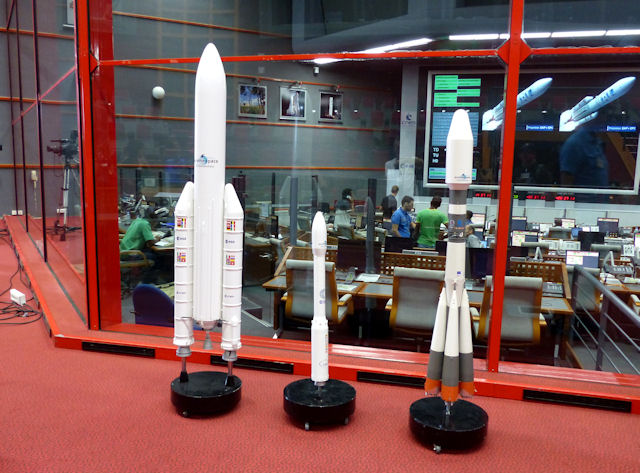
(Scale models of Ariane 5, Vega and Soyuz in the Jupiter Room. This is mission control and the area outside the glass has seating for around 200 VIPs. Separate cubicles accommodate the press with internet & phone hookups.)
We were delighted to discover that for $0 (yep, zero!), Arianespace will load you onto a bus and take you on a 3-hour tour of the facility. It’s over 700 square kms in size and we were trucked around to see assembly buildings, launch sites and control centres as we were guided through every step of a launch from start to finish. All parts are gathered in Europe and delivered to Kourou by ship, we learned, and this is where we had our “aha!” moment as we realized exactly why the guard at that gate was so nervous about two approaching strangers. Security must be high in a port receiving multi-million dollar components for rockets and satellites!
Anyway, there was a lot going on as they were preparing for the upcoming launch of Ariane 5 in less than a week’s time. At first we thought “just our luck” as its launch site was closed and then it dawned on us that maybe, just maybe, we were in the right place at the right time for a change! So we decided to slow our roll by a few days and stay for the launch because, you know, how often does one get to see something like that?! It was touch and go as the weather was dodgy and we were starting to wonder if we’d hung back in vain but the conditions ended up being perfect. Our friends on S/V Tegan had rented a car and driven in from further afield for the launch and they had a line on the perfect lookout onto the launch site -for Joe Publics like us, anyway. And well, what can I say… it was pretty awesome! Normally I’m one to be more impressed with the feats of Mother Nature but I couldn’t help but be moved at Man’s accomplishment as I watched 780 metric tons of metal hurtling out of the atmosphere. Today’s customer was DirecTV and they now have 2 new satellites in orbit around the earth to expand your viewing entertainment. Each one will have a service life of about 15 years which is a good thing as Arianespace charges by the kilo for its launches and this particular endeavour amounted to about 10 million USD -for each satellite. Then you can double this number as it costs about 10 million to build each satellite in the first place! And this is why DirecTV maintains the right to charge you up the wazoo for its services. Now you know.
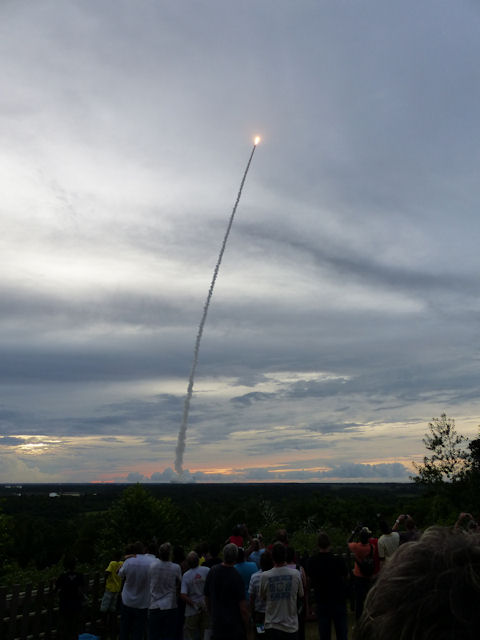
Photos: Fernando de Noronja, Brazil (coming...)
But the whole time we were wandering around we were researching the historical accuracy of the movie for we had just watched it a few days before. More like INaccuracy. Hollywood taking liberties –say it ain’t so! We couldn’t find any of the solitary confinement cells to match what we’d seen in the movie and while we weren’t able to access Devil’s Island itself because of strong currents, it became obvious that the whole cliff-jumping escape at the end was a sham as well (sorry for the spoiler). There were no such cliffs to be seen on any of the three islands. We found out later that the confinement cells were indeed there -we’d just missed them without a tour guide- and as for his grand final escape, it wasn’t even from Devil’s Island but rather from a prison camp on the mainland! We had to contend that this was a far less dramatic ending for a Hollywood production but they weren’t the only guilty ones for we later discovered that most of Papillon’s accounts weren’t even of his own adventures in the first place –he wrote about his fellow inmates! Pffft, what a fraud! Our detective work finished, we left the rolly anchorage of the Îles du Salut (more sleepless nights!) and headed for the Maroni River.
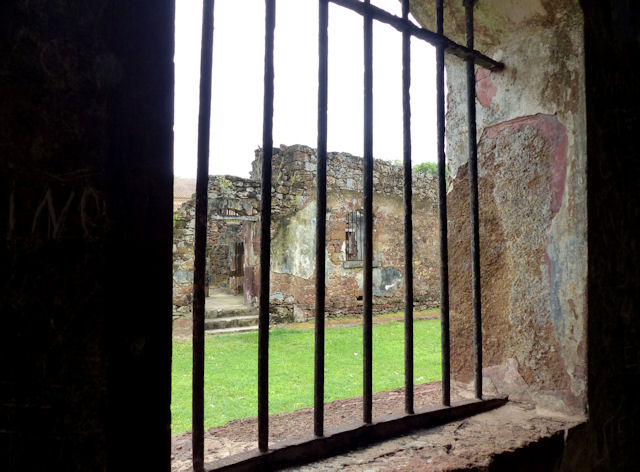
17 June 2015… Raindrops, Rocket and Rage: French Guiana, Part 2
Another 6 hours up a river entrance delivered us to Saint Laurent du Maroni. The Maroni River is a shared border with neighbouring Suriname and it’s neat to look across at the riverside towns of a whole different country. It’s a weird relationship, though, as they call it a “porous border”. Kids run back and forth in local boats (called “pirogues”) to go to school on the French side just as their Surinamese mothers skipped across the border to have them born there in the first place so they (both mom and child) would get the benefits! These kids, who are Surinamese for all intents and purposes, are well looked after in terms of health and education here on the French side. The French government has to be going broke because of it and Saint Laurent has the fastest-developing population of any city in the country. It’s an interesting situation and it’s about to become even more so as we recently heard that changes are in the works on this whole issue.
The anchorage at Saint Laurent is very pretty and we set the hook just off the big island in the middle of the river –or so we thought. Upon closer inspection you’ll see that it’s actually a large shipwreck that Mother Nature is reclaiming! You can board the Edith Cavell and roam around the thick forest emerging from the hulk of her metal. There are also a number of wrecked boats on the shoreline and it does lend a lot of character to the area; the locals see them as yet another piece of their history so they don’t intend to remove them.
The fatigue had been accumulating from our many days of rolly/dodgy anchorages and from our short transit (the shorter ones are more difficult in that regard as the “groove” is gone) but when S/V Tegan invited us on a middle-of-the-night excursion to watch nesting leatherback turtles the answer was a resounding “yes”! “I’ll sleep when I’m dead,” is what I always say and it was totally worth it. First of all, I had no idea how big these turtles are. Six or seven feet long, four to five across and maybe three feet thick, their heads are easily the size of a human’s –and they can get up to 600kg! We were lucky enough to find one who was busy at her task, digging away at a hole to lay her eggs in –she was on a mission and didn’t care one bit about having an audience! She dug. And dug. And dug. How deep does this hole have to be? We wondered if the eggs wouldn’t break with the drop she was creating for them but we later found some dud ones on the beach and their shells are actually soft –to absorb the impact, we found out. We kept watching her dig and it was fascinating as her back flippers were as tactile as hands digging out scoop after scoop of sand. Janet and I were like two kids as
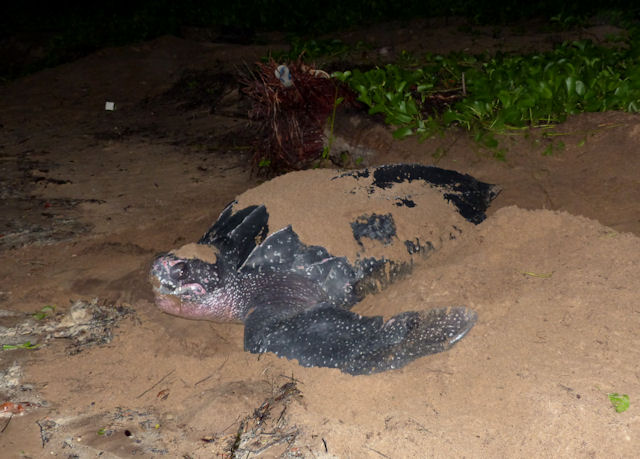
we crouched right behind her butt, watching the ever-deepening hole with a red light, waiting for the moment of delivery; but we finally had to give up as it was 4am and it seemed like it was never coming to a conclusion. So, no payload but it was still such a cool experience to be right up close to this big mama! Here is a photo of another mama, the only flash photo I took -she was done laying her eggs when we got there so it was ok :) .
And then we went home and had what seemed like the best sleep ever.
Around town there was a lot to fill our time. There’s a ton of history here, as the old historic homes and government buildings would attest to, as well as another prison camp which we toured –with a guide this time. Albeit morbid it was still very interesting and the boys even had me shackled up at one point! We perused the cells and saw prisoner artwork etched in to the walls: some of it artistic, some of it just desperate hash marks counting away the days. We saw the concrete blocks where the guillotine was placed on the days its service was required. Apparently the actual item and the basket that used to collect the heads are still upstairs at the Tourist Information Centre but extensive paperwork and permission are required to see it. It’s not on display for fear of offending people. Oh, and Papillon really did spend time here –his old cell has his name scratched into the concrete floor.
The good sleeps would continue on the Maroni River, and for much longer than we expected! Travis had planned on maybe a week in all of French Guiana but the days were stacking up and we weren’t ready to leave yet. Saint Laurent is such an easy place to be and we found a real home at the marina there. David is an excellent host and his new marina is just getting off the ground after three years of paperwork and bureaucracy. Now, with the town council firmly behind the project, he’s starting to see real results. He’s fully installed in his riverside office which not only offers a variety of services that cruisers need (a cruiser himself would know!) but it’s also a fun hangout with the cheapest beer in town and a real Italian cup of coffee! It’s a great place to spend some time, especially in the evenings when the locals come down to relax and the young guys practice their gymnastics at the water’s edge –impressive to watch! We even brought in our grill and had a couple of cookouts. Good company, good location… it’s a real feel-good operation because this marina will provide jobs for locals and help support their economy.
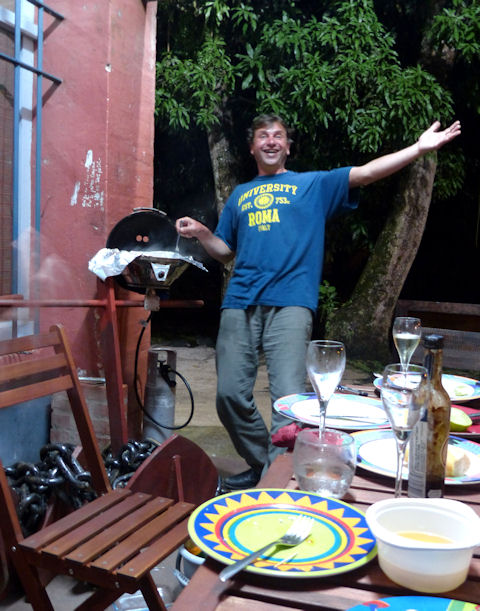
(Here's David cooking up some fish on our grill. That's right: the grill is screwed on to a massive anchor; nearby is a bottle of Veuve chilling in a plastic bucket. Cuz' that's how we roll!)
Three weeks into our one-week visit we were all checked out to leave but not before Travis lent a hand to David to adjust one of his new mooring buoys. The installation hadn’t gone as smoothly as planned in the ripping current of the river and it needed tweaking. It was an onerous task and at the end of it Travis brought David to Calico Jack and showed him all the lift bags we’ve carted around the world (and have fortunately never had to use!), everything he needed to do the job right. He didn’t even have the dive gear to work with because it was tied up in a container at customs and to boot, the Amerindians he’d hired to provide the boat had just bailed on him. Travis was offering for us to stay another week and give him the assistance he needed and David only very reluctantly accepted because he was afraid of putting
us out but really, it was his only feasible option. “Of all the boats that could have floated down the river at just this time…” he mused. As for Travis, he loves that sort of hands-on thing and he was happy to get some use out of the equipment. For me it meant another week of good company at Saint Laurent du Maroni and at least two more feeds of Hmong soup –score! By week’s end, 10 new moorings were in place professional-style with our own Little Sparky providing the transport (though Yertle was replaced with higher horsepower!) and each one has been inspected manually to ensure proper placement. And I do mean “manually” for it was all done by feel: the river is so muddy it’s pitch black 3m below the surface! Travis complained that he smelled like river water for days but a big benefit of soaking in Maroni River water is that its acidic nature makes your bottom clean. Well, at least it did for Calico Jack. Oh dear… Anyway, having the moorings firmly in place and ready for service is a job well-done and David would like to have Travis back in the fall to help again when the approval comes through for the other 10.
Anyone who has read even half these blogs knows how much I love the local markets and consider them a cultural treasure. The one here is particularly exciting because there are stalls that have the best kick-ass bowls of noodle soup, made by Hmong people of Laos, and it comes with a big plate of fresh herbs & lime and a variety of condiments. People were lined up for it first thing in the morning, twice a week. Finally, FINALLY someone who endorses soup for breakfast!! I LOVE THIS PLACE!!! We also enjoyed lunch at a Creole restaurant where the item of interest was the pre-lunch beverage, a ‘Ti Punch. They have this in the French Caribbean islands where it is often mistaken for “Tea Punch” but it’s actually short for “Petit Punch”, meaning “small”, and it comes to your table in several easy components: bottle of Rhum Agricole, bottle of cane sugar syrup, plate of limes, ‘ti glass and ‘ti spoon –muddle it yourself! Oh what fun. And since we’re on about food & beverage, on our last night David treated us to a local Amerindian meal that was amazing. It featured a mystery meat which turned out to be agouti (like a big guinea pig) and a river fish called “jamais gouté” which literally means “haven’t tasted it”. But of course we did, and it was amazing wrapped in banana leaves, after which we could call it “j’avais gouté”, because we had!
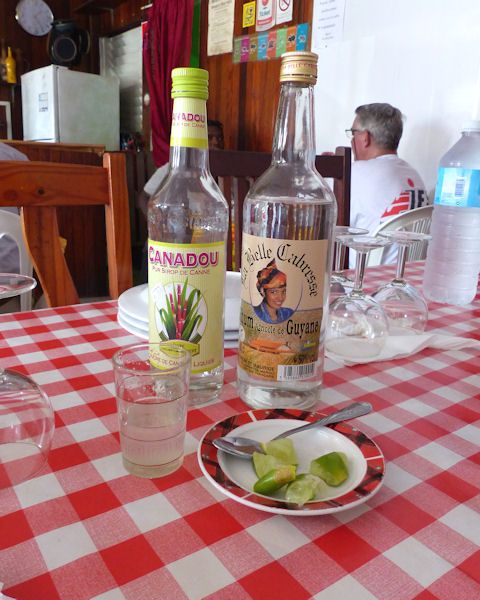
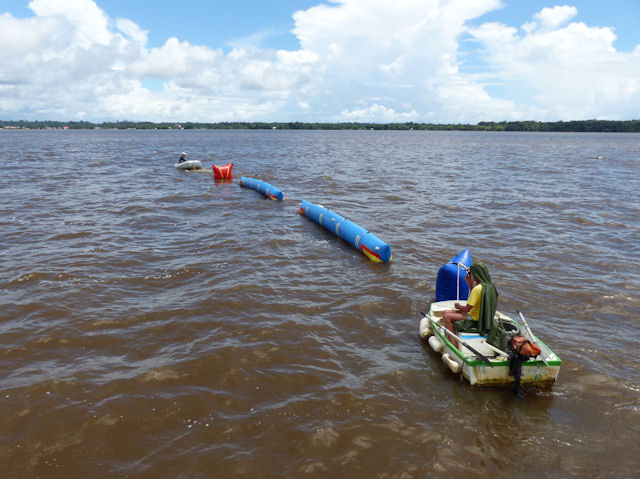
But perhaps the most unique thing we did while in Paramaribo was check out the Sunday birdsong competition. It was an early morning wakeup call to get to the city for this one but it seemed too unusual to miss. Once a week, bird enthusiasts gather at Onafhankelijheidsplein (Independence Square!) with their small feathered friend in tow. These birds have been trained to forget about their native bush calls and whistle tunes instead. They are paired off, cages side by side, and two judges stand and listen attentively while periodically putting a slash mark on a small chalkboard. The bird that can sing the most tunes in 15 minutes wins. Now the chirping sounded like nothing to us –it just blended with the cacophony of some 100 other birds in the park- but one little guy apparently managed to peep out 65 melodies in his allotted time. Way to go little guy!
“Hi Bart,
It took us a while to get out of French Guiana. We were all checked out to leave when Travis volunteered to help the marina owner at Saint Laurent du Maroni install his mooring buoys so we spent an extra week there. After the job was completed we still had trouble leaving but despite bank woes, a wonky tooth and a dog bite we managed to depart on Wednesday. And my husband isn't rabid yet so that's good news, too (could be later this week I'll have to lock him in the front cabin and slip water & dog bickies under the door...).
We're now anchored off Domburg, Suriname and it's very pleasant. We were warmly greeted by fellow cruisers and the majority of them are Dutch -the Dutch are very nice people in case you're ever in this area ;) - and they've been very helpful. Take for example our first evening here. Travis was pretty proud that he had a good grip on the all-Dutch menu. That is, until he discovered that “kip” is chicken, not fish. And “rund” isn't round or balls (for the bitterballen (sp?)). Our new friend Dick van der Waaij tried to help but he couldn't quite remember the word for “beef” and he gestured in such a way that made Travis think he was trying to describe “testicles”. Apparently there's an international man hand gesture for “testicles”? I don't know but it made the other guy at the bar guffaw. We're a comedy show.
Similarly humourous is the two of us in a car. First of all, I should tell you that we have a fascination with speed bumps or rather, what other people call them in other countries. They are “sleeping policemen” in England, “topes” in Mexico and every time we go over one, we have to say what it is. So here, we say “drempel!” often as there are many of them on the crappy road between Domburg and Paramaribo (and what's a “nadereng drempel”?). Then we get to the wegs and straats of the city and how many syllables, exactly, can you guys cram into one word? Seriously, do you even have ANY 1- or 2-syllable words in Dutch? Most of these streets are named after people, I think, so do you, “Bart”, have some crazy multi-syllabic name and you've just dumbed it down for us North 'Mercans?! So because we're obviously Dutch-impaired I must apologize that while navigating the straats of this city with crazy drivers while reading a map with tiny letters, sometimes we just barely manage to get close to the actual word. Watermolenstraat has become "Watermelon Street" and that's probably the kindest example I can give you! Anything with “diljck” or somesuch (far too many consonants!) gets shortened to something much less polite but we mean no disrespect -it's just the best we can do in a hurry while trying to find our next turnoff. My personal favourite is Onafhankelijheidsplein. I've only even attempted that one once, and that was on a big sign where I could move my finger along the word while I probably-butchered it. Needless to say, we've shouted out for your help many times over the last couple of days.
Then there are the ones that make us giggle -that happens pretty much every day, too. I think I would have to cite “winkel” as my favourite here. Come on! You have to see how that sounds funny to an English-speaker! Today it was Museum Winkel. In Simon's Town it was Drankenwinkel -I chuckled every time. Sorry.”
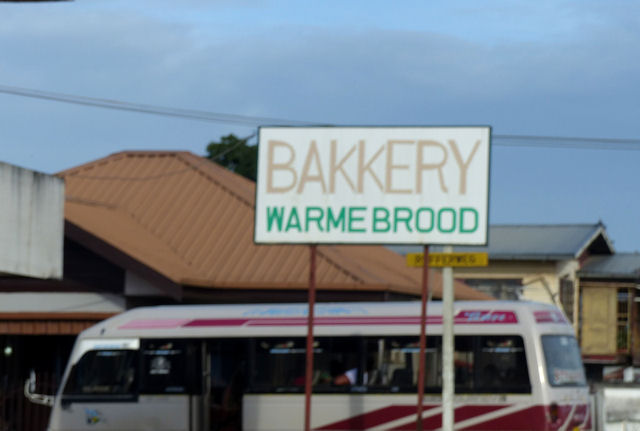
A “winkel” is a store or shop and I was actually mistaken when I referred to the Simon's Town Drankenwinkel for it is actually “drankwinkel” (liquor store). I later issued a formal apology, stating that I might have been drunkenwinkel when I wrote it…
As per the “nadering drempel”, we learned that these were approaching speed bumps. Great. Is it not enough that these drempels lie in wait on the roads at the ready to take out the bottom of the car? NO! It seems they have the variety that stalks us as well! But in truth, the real nadering drempels here are found on the river. These come in the form of giant chunks of earth like mobile islands, sometimes bearing intact trees and grass, and we have to avoid them like a game of Frogger. Calico Jack would notice if she hit one of those bad boys! The trip up the river was also interesting for the quality of the water. Approaching the river mouth I thought we were coming to land or a jetty but it turns out that it was a tidal rip and the colour of the water changed immediately from a cloudy green bathwater hue to the colour of a cup of tea. It was the strangest thing –like driving down a road and seeing the line on the pavement where the rain ended. As we made our way up the Suriname River, the water changed to cappuccino and then another perfect demarcation line as it turned suddenly to café au lait. Fascinating.
The facilities at the River Breeze Resort were good with a nice bar to hang out at and close proximity to a small local market. We also enjoyed our first real shower in 3 MONTHS!! Even if the hot water only lasted the first few minutes it was a real luxury. A hook to hang my things on? My soap isn’t rolling all over the place and I don’t have to hold on for dear life? I can rinse ALL the conditioner out of my hair? Wow. This is livin’.
The capital of Paramaribo is about a half-hour drive away and we had to make the trip three days in a row to get all our things accomplished, namely check-in and the search for Travis’ next round of rabies vaccinations. He had the misfortune of being bit on a Saturday and since the hospital was out of the shot (rash of local dog bites?) and the only other place that might have it was closed on weekends, he got the shot two days late. Still no frothing at the mouth so we’re good there.
When we arrived at the marina in Domburg we discovered that all the moorings were occupied so we looked for a place to anchor where we’d be out of the way. There was a nice big hole at the back of the mooring field but some guy came out of his house on shore and hollered at us, “Further forward!!” A bit awkward especially since “further forward” left us only one option: right in the front, a bit cheeky for a new arrival on a river with a ripping current (we have utter faith and confidence in Fang but it makes other boaters nervous that you might drag into them). But the owner of the marina motioned for us to drop the hook and we did so in front of a happy-hour audience. So much for a quiet, low-key arrival! However, when we went ashore we discovered that everyone was laid back and friendly and our closest neighbour was none-too-concerned about the proximity of our boats. Owners of steel boats tend to be that way and he added, “I’m sure the mooring would support us both if it came to that!” These are seasoned cruisers. Amateurs would be up on the bow shouting, “YOU’RE TOO CLOSE!!!” Still, out of courtesy we did move a little further forward and we sat on the anchor for a day just to make sure we were staying put. In the end we had that crazy hollering guy to thank for the 10-second dinghy ride to shore, plus we could pick up the Wifi on the boat. Bonus!
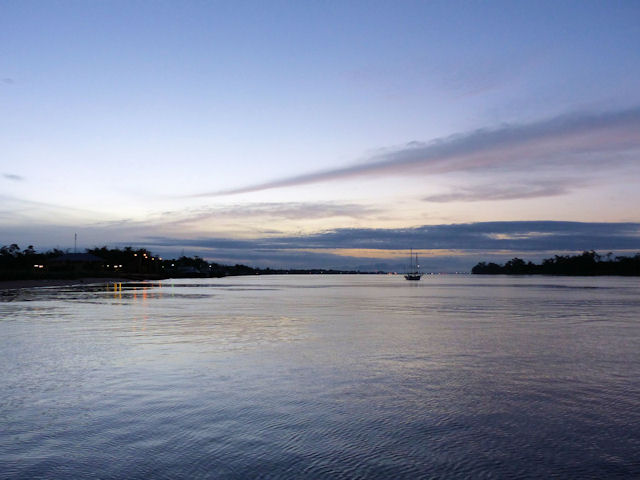
(Sunset on the Suriname River)
In between our errands we made a point of seeing a bit of the city. Paramaribo enjoys UNESCO World Heritage status and is well known for being a cultural melting pot –indigenous South Americans, Dutch, Chinese, Africans, Indonesians and East Indians are just some of the people that make up the population. Walking down the street, the standard Dutch signs are mixed with Chinese and other languages and it’s anybody’s guess as to what language you’ll hear from passersby. Traditional South American buildings mix with Dutch colonial architecture and most of these are intact or slated to be restored. But probably the most unique representation of the city’s multicultural atmosphere has to be the Neveh Shalom Synagogue and the Keizerstraat Mosque sitting contentedly right next to one another! Other notable landmarks include the unassuming Dutch Reformed Church with its massive 19th Century wooden pipe organ, the Presidential Palace, St. Peter and Paul Cathedral and Fort Zeelandia (1667) from which the city originated. The walk down the historic waterfront was lovely and of course a visit to the local market was in order where I actually hurt myself with my roti lunch –I don’t think I’ve been so full in my life and I didn’t even finish it!
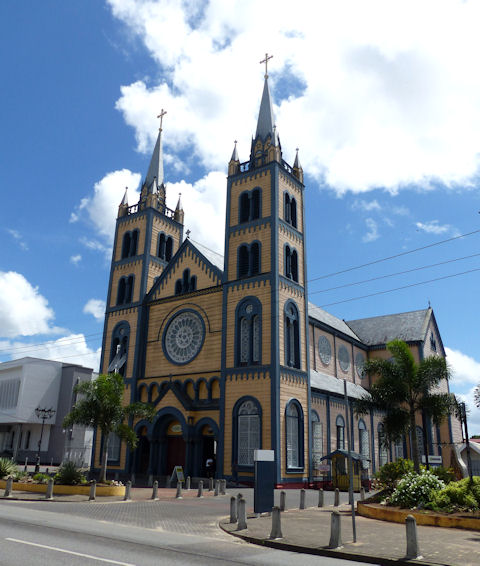
(The St. Peter and Paul Roman Catholic Cathedral (1885) is one of the largest wooden buildings in the Americas. The inside is beautifully ornate, also all in wood: arches, pillars, the works. You can smell the rich aroma of this building even before reaching it!)
**Fun fact: Did you know that the Dutch acquired Suriname by swapping it for New York City? Well, that’s putting it in simple terms. In the 1670s a peace treaty was signed to end the Third Anglo-Dutch war in the future US of A and the Dutch relinquished the territory of New Netherlands -along with the fledgling colony of New Amsterdam- to the English in return for official possession of this corner of South America. Some consider it to be the worst land deal in history (though there is a fair share of mineral resources here including gold so… did they make out SO poorly?). The English renamed the colony New York but because the Dutch weren’t actually kicked out they maintained a strong influence. Words like “cookie” and “coleslaw” are Dutch but also many place names like Brooklyn, Harlem, Coney Island and Broadway owe thanks to their Dutch roots: Breuckelen, Haarlem, Conyne Eylandt and Breede Wegh!
Thanks to www.history.com for the help on this one.
“Bah –that pastime is for the birds!” you might say but it’s a sport to be taken seriously! They’ve been competing since the 1950s and they even have leagues. It’s not a sport for people with busy lives either for it takes at least two hours per day of training to get these birds up to snuff. Given the investment of time, things can get pretty heated on the competition grounds. “That was a song!” “No, it was NOT a song!!” Raised voices, arms flailing and stomping off the grounds are apparently commonplace though we witnessed only one minor dispute. But it’s not all stress on a Sunday as many owners were there with their birds just to hang out and socialize. We witnessed a number of people just walking around the streets with their birds, taking them for a leisurely stroll, and we even saw a few cages strapped on to the back of motorcycles like they were just tagging around with Dad for the day. One guy was selling sprigs of greenery to put in their cages, a treat for man’s OTHER best friend!
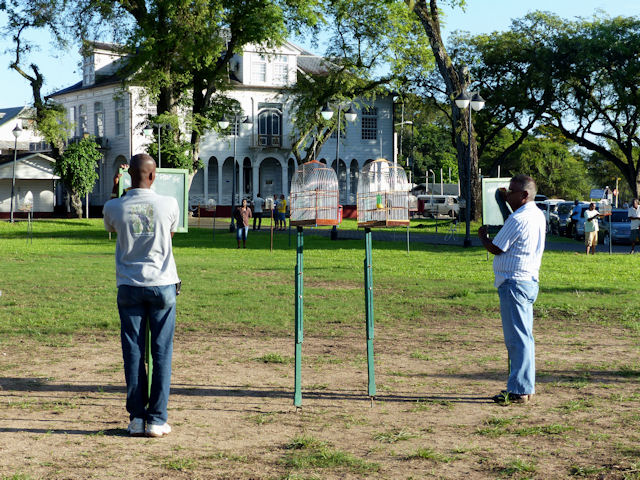
(No pressure, little dudes!)
(Floating the anchors, chain and mooring buoy to their resting spot.)
The Essequibo River is sourced by the mighty Amazon and is the third largest river in South America (the Orinoco in Venezuela being the second). Once again the depth sounder struggled to get readings in spots and if we thought the Suriname River was a game of Frogger this was Frogger V.2.0! First you have to find the opening into the river as the entrance looks like just miles and miles of sticks with fishing nets rigged to them. We trusted the waypoints given to us and everything made sense as we got closer. Once through the shallow entrance the real diligence was required as we had to be on the lookout for flags and buoys that signalled more nets below the surface (underwater speed bumps!). It kept us on our toes as we had to have one eye on the water’s surface, the other on the depth sounder.
12 July 2015… Our Last Jungle Stop
Guyana was never in our plans. The waterways are largely uncharted, there’s nothing nice to be said for the capital of Georgetown and we had heard that crime was rampant on the rivers as well. That’s enough of a deterrent for anybody and undoubtedly why so few people visit this country by boat -they see only about a dozen independent cruisers per year. But our friend David had more to say on this topic and as he brings about a dozen more boats through with his rally every year we took him at his word. A) There does exist one cruising guide for the area, B) the Essequibo River is crime-free and, C) well, just stay away from Georgetown! He also added that it is one of the last undiscovered gems in this area and a must-see before it becomes a popular stop. It would be our last opportunity for sloth and monkey sightings and a bit of peace before we tackle the crowded anchorages of the Caribbean. Besides, we’d already grossly overstayed our planned timeline in the Guianas so why not check out one more country? What’s our hurry anyway? I made the courtesy flag on the fly and so it was a done deal (criterion: if I’ve made the flag, we’re going!).
One week later and we’re getting ready to leave again when Travis gets nipped saving a drowning dog. The poor pooch seemed healthy and alert -he nipped only out of fear and it was little more than a scratch- but nonetheless, we had to see about vaccinations for rabies because it’s a concern here (we’re vaccinated for pretty much everything but). This involved dealings with the people at rabies control in the capital of Cayenne, who were great, but it also led to two encounters with a doctor at the local hospital who felt it was within his rights to yell at me (the French speaker). I believe the crux of the problem was that he’s not used to being questioned –people here are just happy for the free care and will swallow whatever pill he doles out without hesitation. The situation didn’t improve when we had to return a second time because HE made a mistake in not giving two shots to begin with (so the pros in Cayenne informed us) and I just sat there while he interrupted me and two of them yelled at me again -Travis didn’t need to speak French to know I was getting yelled at! “Eye on the prize,” I kept telling myself because we really needed the shots but it was still frustrating to be treated in that manner for no good reason. Interestingly enough, rabies in French is called “la rage”. Dealing with the doctors here was more cause for rage than the dog bite ever was.
So we’re all checked out again and ready to leave when we discover a bogus charge on our card which needs dealing with because we’ll be offshore for a couple of days. Then I notice I’m having a flare-up with my dodgy tooth…Good grief! It’s like this country doesn’t want us to leave!! But we got everything sorted by the next day and were finally ready to depart for reals. This was one of those sad goodbyes as we’d enjoyed good company and made great new friends in David, his sweet and funny mum Lucilla, and we even managed to convince a set-in-his-ways old Frenchman that there are some Americans out there worth knowing. Our work here is done.
Photos: (Later, skaters)
29 June 2015… A Letter to Our Dutch Friend
We’ve managed three-quarters of the world quite well with our English, French and Spanish. Our only real stumbling block has been Indonesia, as our Spanish got us by well enough in Brazil. Here’s how we’re doing in Suriname:
We actually didn’t “do” a lot in Guyana. The big attraction is Kaiteur Falls which are supposed to be amazing, giving more well-known waterfalls a run for their money, but they are commonly visited by plane and the tickets were more than our budget would allow for. So instead we chilled out off two of the river resorts with Bartica as our base in between. We thought it safest to move only at high tide since Garmin has no readings for anything upriver of the town and it’s a lot of faith to have in someone else’s waypoints! Usually one would fall back on eyeball navigation but the opaque, muddy, tannin-stained river makes this a sketchy undertaking. All you can do it keep your eyes peeled for disturbances in the water, stay glued to the depth sounder and use common sense where necessary. Oh –and only approach something as fast as you want to hit it, as Travis always says!
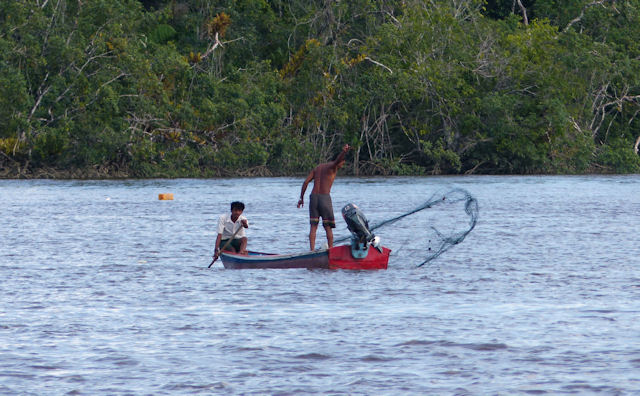
(Deploying the fishing nets)
Still, river cruising is interesting and working with the tides it was two days and 40 nautical miles up to the town of Bartica. Our track had us motoring 75ft away from pure jungle dotted by the occasional riverside home with a cluster of colourful fishing boats parked out front. In contrast is a duo of small islands belonging to Eddy Grant –nope, I didn’t know he’s from Guyana, either! A giant extravagant home covers every surface of one island while the other looks like more humble staff housing. The two are connected by a bridge. While probably the envy of many, it seemed very out of place in the natural setting.
The Guianas in general have a reputation for being more Caribbean than South American but nowhere was this more obvious than in Guyana. We didn’t know what to expect in Bartica but we were met with island lingo, style and music. The familiar reggae, calypso and soca could be heard in the air as well as chutney which is a fusion of Caribbean and Indian styles, something popular in this area but new to us! The laid-back Caribbean attitude also prevailed and everyone was friendly and check-in was easy. We discovered that we were one of only two cruising boats on the river. That and the lack of facilities for cruisers confirmed what we were told: this really is off the beaten track. David likes to call it “the wild west” which is fitting as it’s a mining town, serving as a base for those working in the interior for the gold, bauxite, diamond and manganese industries, just to name a few (a number of them Canadian-owned companies, by the way). It is in this general area that they searched for the mythical golden city of El Dorado! It proved fruitless, though, and these days El Dorado is the brand name of their very yummy local rum.
(Get a load of this “dinghy dock”! This is low tide and Travis is climbing down the side of the rotting dock. He'll then trust those two bottom steps to get him into that white water taxi and scramble over to our dinghy tied off to it. At high tide, those steps are underwater so he balances on either the rotting beam or the skinny metal rod at the top and jumps. Travis is part monkey so he loves this stuff, but it's not for everyone!)
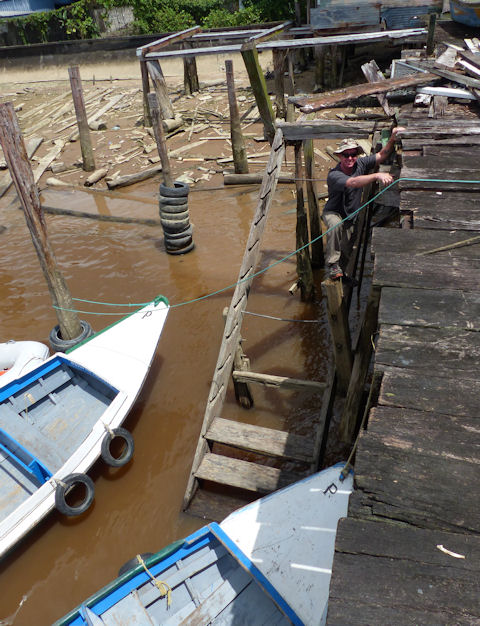
We met some nice people at both resorts including a very friendly Cuban bartender and his brother. We had them all to ourselves it was so slow, and we had some great conversations. We spoke briefly to some Canadians and some Floridians who were there for a family reunion (proving that most of the tourism here in this developing industry is from family ties) and we had a young American couple aboard who were curious about the whole cruising lifestyle (not sure we converted them, though!). And we can’t forget about our favourite veggie guy in town, Ahmed! On our final parting he gifted us a beautiful avocado and said that he enjoyed selling his veggies to us, to which we replied that we enjoyed buying them from him! He was always great for a visit.
The twelve days in Guyana went quickly as travelling strictly at high tide meant that only a single one-hour change in location could happen per day; factor in also the two days up and down the river. And we enjoyed our time there but near the end we found ourselves beginning to get antsy. I worried that it could be that we were sitting still for too long (what will we do when we have to stop?) but we thought moreover that we were just missing the blue waters for swimming. And the sunshine! WOW it can rain in this region!! It rained so white on the way up the river that we had to stop for lack of visibility; when we got caught out in the kayak the rain pelted our skin to the point of pain! We have been perpetually soaked in the Guianas and my toes are permanently muddy –there’s no saving them. And no fun for Calico Jack either as a large part of our chores over the last 8 weeks has had to do with chasing leaks and fighting mould that we never normally have a problem with. But as always, there’s a bright side: we haven’t had to cart water in two months as I’ve become a water-collecting demon. Showers can be had for as long as we want and anything that needed hand washing like cushion covers, etc. is done –though drying them efficiently in this damp environment is a challenge.
But we got through without any hiccups and enjoyed peaceful days and evenings on the river under a big fat moon all to ourselves. We took care of some chores including hauling me up the mast for an inspection. We broke out the kayak and paddled around to the tune of the woodpeckers -and the pouring rain!- and Travis braved swimming in the muddiest waters yet, despite warnings of electric eels and “things with teeth”. If he’d been taken down there would have been no hope for saving him as he completely disappeared about 6 inches below the water’s murky surface! Supposedly there are shrimp in the river and we deployed our new shrimp trap, a gift from David and Lucilla, in hopes of scoring some dinner but no dice. Frankly, we’re not sure how the little guys would even be able to hold on down there, the current is so strong. All we hauled in was the bait we had laid out, ever more disgusting for having been soaking in the river overnight. Yuck!
Another quick stop at Fort Island in the morning was pleasant as well. It’s the site of Fort Zeelandia (1744) and it has a small museum that was closed on a Sunday but we enjoyed walking around the interesting little shoreside community. As we lifted the anchor to leave, we had another guy yelling at us from the shore –two for two in these countries! By the reaction of his fellow townspeople I think he was just crazy but it was still unnerving. No matter, though, as we were on our way. We exited the river with its minefield of fish traps just as it was getting too dark to see -it was close!- and we bid farewell to South America.
Anyway, we started making our way back down the river and were met with a wonderful surprise. Apparently there’s an island that everyone used to go to for the large population of wild parrots. Recently, however, they’ve been displaced by other birds and nobody knows where the parrots have gone. Well, we found them! In looking for a place on the river to set the hook for the night, why wouldn’t you choose the island with the screaming parrots?! Again, not 75ft from the jungle, we had happy hour to the tune of these beautiful birds -hundreds and hundreds of them- as they set off home for the evening. When their cacophony was over, we enjoyed a beautiful sunset and then the cicadas and the toads kicked in. Travis had been disappointed that the only jungle animals we’d seen were some monkeys at one of the resorts but now our needs had been met. And we had it all to ourselves.
p.s. No rabies shots available here for Travis to take his final dose but we’ve been through a full moon now and I didn’t have to lock him away!
**Not-fun fact: Guyana is home to Jonestown, near the border of Venezuela. I had no idea –I thought it was in the US. Although I could be forgiven, I suppose, as I was only 10 years old at the time…
